Progress in Material Development for Low-Temperature Solid Oxide Fuel Cells: A Review
Abstract
1. Introduction
1.1. Structure of SOFCs
1.1.1. SOFC Individual Layers
- Transportation of fuel molecules into the porous structure of anode and their adsorption onto the anode surface.
- Diffusion of adsorbed fuel species to the TPBs and simultaneously, desorption of the product of electro-catalytically species from the anode surface.
- Transportation of oxide ions (O2−) across the electrolyte, followed by diffusion of them to the TPBs.
- Releasing the electrons from the charged species into the bulk of the anode electrocatalytic constituents at the TPB.
- Extension of active TPBs, which are well-interconnected to the available ionic-electronic conduction paths and mass-transfer channels at the SOFC anode structure.
1.1.2. State-of-the-Art SOFC Materials
1.1.3. Characteristics and Performance of Electrolyte-Supported SOFCs
1.1.4. SOFC Fabrication and Geometries
1.2. Low-Temperature SOFCs (L-T SOFCs)
- Maximizing the cell open-circuit voltage by optimizing the physiochemical properties of the electrolyte materials without the side effects like increased ASR
- Compensation of the electrodes thermal activation by manipulating the material microstructure
2. Advances in Low-Temperature SOFC Electrolytes (L-T SOFC)
2.1. Ionic Conductivity and Electrochemical Performance
2.2. State-of-the-Art Electrolytes
2.2.1. High-Temperature Electrolytes
2.2.2. Intermediate-Temperature Electrolytes
2.2.3. Low-Temperature Electrolytes
Ceria-Based Electrolytes
Zirconia-Based Electrolytes
ZnO-Based Electrolytes
Carbonate-Based Electrolytes
Apatite-Structured Electrolytes
Bismuth-Based Electrolytes
- α-Bi2O3 with monoclinic crystal structure;
- β-Bi2O3 with tetragonal crystal structure (fluorite);
- δ-Bi2O3 with face-centered cubic crystal structure (FCC);
- γ-Bi2O3 with body-centered cubic crystal structure (BCC);
- ω-Bi2O3 with triclinic crystal structure;
- ε-Bi2O3 with orthorhombic crystal structure.
3. Modern Low-Temperature SOFC Electrodes and Interconnects
3.1. Electrode and Current Collectors’ Prospects
3.1.1. Choice of Anodes
3.1.2. Choice of Cathodes
3.1.3. Choice of Interconnects
3.2. Operational and Fuel Prospects
4. Technological Aspects for Low-Temperature Stack Design
4.1. Stack Design Technologies
4.2. Synthesis Methods and Conditions
4.3. Choice of Sealant
4.4. Current Challenges, Operational Costs, and Performance Prospects of L-T SOFCs
5. Conclusions
- Lowering the operating temperature of SOFCs offers excellent advantages, including broader options for selecting materials, lower costs, lower degradation, etc. However, reducing the SOFC operating temperature can also increase cell polarization losses, resulting in reduced electrochemical performance, overall. Thus, novel and cost-effective materials should be developed for different cell components, namely anode, cathode, electrolyte, and interconnects.
- The L-T SOFC Electrolytes should possess a high ionic conductivity as well as good chemical stability, matching TEC to those of other components, and low ohmic loss. The fabricated electrodes should have high electrical conductivity (>1 S·cm−1), with a matching TEC, high chemical stability, and proper catalytic activity. Interconnect materials for the L-T region should provide a high electronic conductivity along with good chemical compatibility and matching TEC. The most common interconnect materials for low-temperature applications are metal- or alloy-based ones. In addition to the high mechanical and thermal resistivity, sealants should exhibit a desirable electrical conductivity. Two types of sealants, including the rigid and compressive seals, could be used for the L-T SOFCs overall.
- Fuel optimization plays an important role in achieving high electrochemical performance. Fuel flexibility, cost-effectiveness, fuel size, and catalyst tolerance are the most important parameters in obtaining effective fuel from the processor. Diesel, gasoline, hydrogen, ethanol, methanol, ammonia, natural gas, etc., are the most prevalent fuels with their own advantages and disadvantages that should be considered in choosing the right fuel for the system. Generally, hydrogen and liquid fuels are the most common fuel for closed systems and light vehicle operating in the low-temperature region.
- Different stack designs have been developed for the L-T SOFCs, including honeycomb, microtubular, cone-shaped, and flat-tube. The integrated-planar design is one of the most predominant stack designs for the planar and tubular SOFC geometries. The appropriate geometry should be selected according to the engineering and design factors.
- Fabrication of the L-T SOFCs needs to be improved and optimized in terms of the rate of fuel utilization, gas management, electrical collection, etc. Each fabrication method and synthesis condition can result in a distinctive microstructure and electrochemical performance. Some fabrication methods such as tape-casting and screen-printing showed promising potential for the large-scale fabrication of L-T SOFCs. Thus, choosing the appropriate fabrication method for the individual cell layers is crucial in order to lower the operating temperature of the SOFCs.
- In addition to the efficiency and performance of the SOFCs, several other aspects should be considered, including cost-effectiveness, availability, economic feasibility, and the sustainability and priority of the research materials. Regarding the choice of fuel, pollution, and environmental aspects of the fuel should be considered along with the other parameters discussed earlier.
Author Contributions
Funding
Institutional Review Board Statement
Informed Consent Statement
Conflicts of Interest
References
- Singh, B.; Ghosh, S.; Aich, S.; Roy, B. Low temperature solid oxide electrolytes (LT-SOE): A review. J. Power Sources 2017, 339, 103–135. [Google Scholar] [CrossRef]
- Faro, M.L.; La Rosa, D.; Antonucci, V.; Aricó, A.S. Intermediate temperature solid oxide fuel cell electrolytes. J. Indian Inst. Sci. 2009, 89, 363–380. [Google Scholar]
- Lee, S.; Lee, K.; Jang, Y.H.; Bae, J. Fabrication of solid oxide fuel cells (SOFCs) by solvent-controlled co-tape casting technique. Int. J. Hydrogen Energy 2016, 42, 1648–1660. [Google Scholar] [CrossRef]
- Song, C.; Lee, S.; Gu, B.; Chang, I.; Cho, G.Y.; Baek, J.D.; Cha, S.W. A Study of Anode-Supported Solid Oxide Fuel Cell Modeling and Optimization Using Neural Network and Multi-Armed Bandit Algorithm. Energies 2020, 13, 1621. [Google Scholar] [CrossRef]
- Baldi, F.; Moret, S.; Tammi, K.; Maréchal, F. The role of solid oxide fuel cells in future ship energy systems. Energy 2020, 194. [Google Scholar] [CrossRef]
- Lerson, S.; Lilien, J.L.; Minne, G. Performance assessment of a 5 kW SOFC cogeneration fuel cell. Int. J. Environ. Technol. Manag. 2008, 9, 426–433. [Google Scholar] [CrossRef]
- Shri Prakash, B.; Pavitra, R.; Senthil Kumar, S.; Aruna, S.T. Electrolyte bi-layering strategy to improve the performance of an intermediate temperature solid oxide fuel cell: A review. J. Power Sources 2018, 381, 136–155. [Google Scholar] [CrossRef]
- Jaiswal, N.; Tanwar, K.; Suman, R.; Kumar, D.; Uppadhya, S.; Parkash, O. A brief review on ceria based solid electrolytes for solid oxide fuel cells. J. Alloys Compd. 2019, 781, 984–1005. [Google Scholar] [CrossRef]
- Da Silva, F.S.; De Souza, T.M. Novel materials for solid oxide fuel cell technologies: A literature review. Int. J. Hydrogen Energy 2017, 42, 26020–26036. [Google Scholar] [CrossRef]
- Choolaei, M.; Cai, Q.; Slade, C.T.; Horri, B.A. Nanocrystalline gadolinium-doped ceria (GDC) for SOFCs by an environmentally-friendly single step method. Ceram. Int. 2018, 44, 13286–13292. [Google Scholar] [CrossRef]
- Fabbri, E.; Pergolesi, D.; Traversa, E. Materials challenges toward proton-conducting oxide fuel cells: A critical review. Chem. Soc. Rev. 2010, 39, 4355–4369. [Google Scholar] [CrossRef] [PubMed]
- Caton, J.A. Maximum efficiencies for internal combustion engines: Thermodynamic limitations. Int. J. Engine Res. 2018, 19, 1005–1023. [Google Scholar] [CrossRef]
- Qiao, Z.; Xia, C.; Cai, Y.; Afzal, M.; Wang, H.; Qiao, J.; Zhu, B. Electrochemical and electrical properties of doped CeO2-ZnO composite for low-temperature solid oxide fuel cell applications. J. Power Sources 2018, 392, 33–40. [Google Scholar] [CrossRef]
- Irshad, M.; Siraj, K.; Raza, R.; Ali, A.; Tiwari, P.; Zhu, B.; Rafique, A.; Ali, A.; Ullah, M.K.; Usman, A. A brief description of high temperature solid oxide fuel cell’s operation, materials, design, fabrication technologies and performance. Appl. Sci. 2016, 6, 75. [Google Scholar] [CrossRef]
- Zakaria, Z.; Mat, Z.A.; Hassan, S.H.A.; Kar, Y.B. A review of solid oxide fuel cell component fabrication methods toward lowering temperature. Int. J. Energy Res. 2019, 44, 594–611. [Google Scholar] [CrossRef]
- Wachsman, E.D.; Lee, K.T. Lowering the temperature of solid oxide fuel cells. Science 2011, 334, 935–939. [Google Scholar] [CrossRef]
- Lyu, Y.; Xie, J.; Wang, D. Review of cell performance in solid oxide fuel cells. J. Mater. Sci. 2020, 55, 7184–7207. [Google Scholar] [CrossRef]
- Lu, Y.; Zhu, B.; Cai, Y.; Kim, J.S.; Wang, B.; Wang, J.; Zhang, Y.; Li, J. Progress in electrolyte-free fuel cells. Front. Energy Res. 2016, 4, 17. [Google Scholar] [CrossRef]
- Andújar, J.M.; Segura, F. Fuel cells: History and updating: A walk along two centuries. Renew. Sustain. Energy Rev. 2009, 13, 2309–2322. [Google Scholar] [CrossRef]
- Fan, L.; Wang, C.; Chen, M.; Zhu, B. Recent development of ceria-based (nano)composite materials for low temperature ceramic fuel cells and electrolyte-free fuel cells. J. Power Sources 2013, 234, 154–174. [Google Scholar] [CrossRef]
- Fan, L.; Zhu, B.; Su, P.C.; He, C. Nanomaterials and technologies for low temperature solid oxide fuel cells: Recent advances, challenges and opportunities. Nano Energy 2018, 45, 148–176. [Google Scholar] [CrossRef]
- Al Kharusi, H.; Svensson, M.; Salamatinia, B.; Horri, B.A. Gelling synthesis of NiO/YSZ nanocomposite powder for solid oxide fuel cells. Adv. Mater. Proc. 2017, 2, 813–818. [Google Scholar] [CrossRef][Green Version]
- Choudhury, A.; Chandra, H.; Arora, A. Application of solid oxide fuel cell technology for power generation-A review. Renew. Sustain. Energy Rev. 2013, 20, 430–442. [Google Scholar] [CrossRef]
- Lee, K.; Kang, J.; Lee, J.; Lee, S.; Bae, J. Evaluation of metal-supported solid oxide fuel cells (MS-SOFCs) fabricated at low temperature (∼1,000 °C) using wet chemical coating processes and a catalyst wet impregnation method. Int. J. Hydrogen Energy 2018, 43, 3786–3796. [Google Scholar] [CrossRef]
- Pezeshkpour, S.; Abdullah, A.Z.; Salamatinia, B.; Amini Horri, B. Ionic–gelation synthesis of gadolinium doped ceria (Ce0.8Gd0.2O1.90) nanocomposite powder using sodium-alginate. Ceram. Int. 2017, 43, 7123–7135. [Google Scholar] [CrossRef]
- Zhu, B.; Lund, P.D.; Raza, R.; Ma, Y.; Fan, L.; Afzal, M.; Patakangas, J.; He, Y.; Zhao, Y.; Tan, W.; et al. Schottky junction effect on high performance fuel cells based on nanocomposite materials. Adv. Energy Mater. 2015, 5, 1–6. [Google Scholar] [CrossRef]
- Mahato, N.; Banerjee, A.; Gupta, A.; Omar, S.; Balani, K. Progress in material selection for solid oxide fuel cell technology: A review. Prog. Mater. Sci. 2015, 72, 141–337. [Google Scholar] [CrossRef]
- Lim, H.H.; Sulistya, E.; Wong, M.Y.; Salamatinia, B.; Horri, B.A. Ceramic Nanocomposites for Solid Oxide Fuel Cells; Springer International Publishing AG: Berlin/Heidelberg, Germany, 2017; pp. 157–183. ISBN 9783319495125. [Google Scholar]
- Wang, W.; Qu, J.; Julião, P.S.B.; Shao, Z. Recent Advances in the Development of Anode Materials for Solid Oxide Fuel Cells Utilizing Liquid Oxygenated Hydrocarbon Fuels: A Mini Review. Energy Technol. 2019, 7, 33–44. [Google Scholar] [CrossRef]
- Wincewicz, K.C.; Cooper, J.S. Taxonomies of SOFC material and manufacturing alternatives. J. Power Sources 2005, 140, 280–296. [Google Scholar] [CrossRef]
- Radhika, D.; Nesaraj, A.S. Materials and components for low temperature solid oxide fuel cells–An overview. Int. J. Renew. Energy Dev. 2013, 2, 87–95. [Google Scholar] [CrossRef]
- Mirzababaei, J.; Chuang, S.S.C. La0.6Sr0.4Co0.2Fe0.8O3 perovskite: A stable anode catalyst for direct methane solid oxide fuel cells. Catalysts 2014, 4, 146–161. [Google Scholar] [CrossRef]
- Koteswararao, P.; Suresh, B.M.; Wain, B.N.; Rao, P.V.B. Review on Different Components of Solid Oxide Fuel Cells. J. Powder Metall. Min. 2017, 6, 181. [Google Scholar] [CrossRef]
- Larminie, J.; Dicks, A. Fuel Cell Systems Explained, 2nd ed.; John Wiley & Sons Ltd.: Chichester, UK, 2003; Volume 93, ISBN 9780470848579. [Google Scholar]
- Yang, S.; Chen, T.; Wang, Y.; Peng, Z.; Wang, W.G. Electrochemical analysis of an anode-supported SOFC. Int. J. Electrochem. Sci. 2013, 8, 2330–2344. [Google Scholar]
- Tarancón, A. Strategies for lowering solid oxide fuel cells operating temperature. Energies 2009, 2, 1130–1150. [Google Scholar] [CrossRef]
- Mah, J.C.W.; Muchtar, A.; Somalu, M.R.; Ghazali, M.J. Metallic interconnects for solid oxide fuel cell: A review on protective coating and deposition techniques. Int. J. Hydrogen Energy 2017, 42, 9219–9229. [Google Scholar] [CrossRef]
- Wu, J.; Liu, X. Recent development of SOFC metallic interconnect. J. Mater. Sci. Technol. 2010, 26, 293–305. [Google Scholar] [CrossRef]
- Muccillo, R.; Muccillo, E.N.S.; Fonseca, F.C.; De Florio, D.Z. Characteristics and Performance of Electrolyte-Supported Solid Oxide Fuel Cells under Ethanol and Hydrogen. J. Electrochem. Soc. 2008, 155, B232. [Google Scholar] [CrossRef]
- Taroco, H.A.; Santos, J.A.F.; Domingues, R.Z.; Matencio, T. Ceramic Materials for Solid Oxide Fuel Cell. In Advances in Ceramics-Synthesis and Characterization, Processing and Specific Applications; Sikalidis, C., Ed.; Intech: Rijeka, Croatia, 2011; pp. 423–446. [Google Scholar]
- Hall, J.L. Fuel Cell Handbook, 7th ed.; EG&G Technical Services, Inc.: Norfolk, VA, USA, 2004. [Google Scholar]
- Sin, A.; Kopnin, E.; Dubitsky, Y.; Zaopo, A.; Aricò, A.S.; Gullo, L.R.; Rosa, D.L.; Antonucci, V. Stabilisation of composite LSFCO-CGO based anodes for methane oxidation in solid oxide fuel cells. J. Power Sources 2005, 145, 68–73. [Google Scholar] [CrossRef]
- Huang, T.J.; Chou, C.L.; Chen, W.J.; Huang, M.C. Coal syngas reactivity over Ni-added LSCF-GDC anode of solid oxide fuel cells. Electrochem. Commun. 2009, 11, 294–297. [Google Scholar] [CrossRef]
- Afzal, M.; Saleemi, M.; Wang, B.; Xia, C.; Zhang, W.; He, Y.; Jayasuriya, J.; Zhu, B. Fabrication of novel electrolyte-layer free fuel cell with semi-ionic conductor (Ba0.5Sr0.5Co0.8Fe0.2O3−δ- Sm0.2Ce0.8O1.9) and Schottky barrier. J. Power Sources 2016, 328, 136–142. [Google Scholar] [CrossRef]
- Ralph, J.M.; Schoeler, A.C.; Krumpelt, M. Materials for lower temperature solid oxide fuel cells. J. Mater. Sci. 2001, 36, 1161–1172. [Google Scholar] [CrossRef]
- Minh, N.Q.; Takahashi, T.I.K. Science and Technology of Ceramic Fuel Cells, 1st ed.; Elsevier: Amsterdam, The Netherlands, 1995. [Google Scholar]
- Sun, C.; Hui, R.; Roller, J. Cathode materials for solid oxide fuel cells: A review. J. Solid State Electrochem. 2010, 14, 1125–1144. [Google Scholar] [CrossRef]
- Jacobson, A.J. Materials for solid oxide fuel cells. Chem. Mater. 2010, 22, 660–674. [Google Scholar] [CrossRef]
- Suresh, M.B.; Yeh, T.H.; Chou, C.C. Zn doped LSCF as a novel cathode material for solid oxide fuel cell. Integr. Ferroelectr. 2010, 121, 113–119. [Google Scholar] [CrossRef]
- Zhu, Z.; Li, M.; Xia, C.; Bouwmeester, H.J.M. Bismuth-doped La1.75Sr0.25NiO4+δ as a novel cathode material for solid oxide fuel cells. J. Mater. Chem. A 2017, 5, 14012–14019. [Google Scholar] [CrossRef]
- Shi, T.; Chen, Y.; Guo, X. Defect chemistry of alkaline earth metal (Sr/Ba) titanates. Prog. Mater. Sci. 2016, 80, 77–132. [Google Scholar] [CrossRef]
- Schmid, A.; Fleig, J. The Current-Voltage Characteristics and Partial Pressure Dependence of Defect Controlled Electrochemical Reactions on Mixed Conducting Oxides. J. Electrochem. Soc. 2019, 166, F831–F846. [Google Scholar] [CrossRef]
- Taylor, F.H.; Buckeridge, J.; Catlow, C.R.A. Defects and oxide ion migration in the solid oxide fuel cell cathode material LaFeO3. Chem. Mater. 2016, 28, 8210–8220. [Google Scholar] [CrossRef]
- Schmid, A.; Rupp, G.M.; Fleig, J. Voltage and partial pressure dependent defect chemistry in (La,Sr)FeO3-δ thin films investigated by chemical capacitance measurements. Phys. Chem. Chem. Phys. 2018, 20, 12016–12026. [Google Scholar] [CrossRef] [PubMed]
- Petrovsky, V.; Anderson, H.U.; Petrovsky, T. Application of composite technology for SOFCs. In Proceedings of the Materials Research Society Symposium Proceedings; Springer: Berlin/Heidelberg, Germany, 2004; Volume 822, pp. 147–152. [Google Scholar]
- Muhoza, S.P.; Lee, S.; Song, X.; Guan, B.; Yang, T. Enhancing Activity, Charge Transport, Power Production, and Stability of Commercial Solid Oxide Fuel Cells with Yttria-Stabilized Zirconia Nanoparticles. J. Electrochem. Soc. 2020, 167, 024517. [Google Scholar] [CrossRef]
- Roehrens, D.; Packbier, U.; Fang, Q.; Blum, L.; Sebold, D.; Bram, M.; Menzler, N. Operation of thin-film electrolyte metal-supported solid oxide fuel cells in lightweight and stationary stacks: Material and microstructural aspects. Materials 2016, 9, 762. [Google Scholar] [CrossRef] [PubMed]
- Zhang, K.; Ge, L.; Ran, R.; Shao, Z.; Liu, S. Synthesis, characterization and evaluation of cation-ordered LnBaCo2O5+δ as materials of oxygen permeation membranes and cathodes of SOFCs. Acta Mater. 2008, 56, 4876–4889. [Google Scholar] [CrossRef]
- Sunarso, J.; Baumann, S.; Serra, J.M.; Meulenberg, W.A.; Liu, S.; Lin, Y.S.; Diniz da Costa, J.C. Mixed ionic-electronic conducting (MIEC) ceramic-based membranes for oxygen separation. J. Membr. Sci. 2008, 320, 13–41. [Google Scholar] [CrossRef]
- Riess, I. Mixed ionic-electronic conductors-Material properties and applications. Solid State Ion. 2003, 157, 1–17. [Google Scholar] [CrossRef]
- Wu, X.; Gu, C.; Cao, J.; Miao, L.; Fu, C.; Liu, W. Investigations on electrochemical performance of La2NiO4+δ cathode material doped at A site for solid oxide fuel cells. Mater. Res. Express 2020, 7, 065507. [Google Scholar] [CrossRef]
- He, Y.; Fan, L.; Afzal, M.; Singh, M.; Zhang, W.; Zhao, Y.; Li, J.; Zhu, B. Cobalt oxides coated commercial Ba0.5Sr0.5Co0.8Fe0.2O3-δ as high performance cathode for low-temperature SOFCs. Electrochim. Acta 2016, 191, 223–229. [Google Scholar] [CrossRef]
- Gao, J.; Li, Q.; Guo, M.; Sun, L.; Huo, L.; Zhao, H. Improved electrochemical activity of Bi0.5Sr0.5FeO3-δ–Ce0.9Gd0.1O1.95 composite cathode electrocatalyst for solid oxide fuel cells. Ceram. Int. 2021, 47, 748–754. [Google Scholar] [CrossRef]
- Mo, B.; Rix, J.; Pal, U.; Basu, S.; Gopalan, S. Characterizing Performance of Electrocatalyst Nanoparticles Infiltrated into Ni-YSZ Cermet Anodes for Solid Oxide Fuel Cells. J. Electrochem. Soc. 2020, 167, 054515. [Google Scholar] [CrossRef]
- Nielsen, J.; Persson, Å.H.; Muhl, T.T.; Brodersen, K. Towards High Power Density Metal Supported Solid Oxide Fuel Cell for Mobile Applications. J. Electrochem. Soc. 2018, 165, F90–F96. [Google Scholar] [CrossRef]
- Leah, R.; Bone, A.; Lankin, M.; Selcuk, A.; Rahman, M.; Clare, A.; Rees, L.; Phillip, S.; Mukerjee, S.; Selby, M. Ceres Power Steel Cell Technology Rapid Progress Towards a Truly Commercially Viable SOFC. ECS Trans. 2015, 67, 95–107. [Google Scholar] [CrossRef]
- Lee, K.T.; Yoon, H.S.; Wachsman, E.D. The evolution of low temperature solid oxide fuel cells. J. Mater. Res. 2012, 27, 2063–2078. [Google Scholar] [CrossRef]
- Wang, A.B.; Cai, Y.; Xia, C.; Liu, Y.; Dong, W.; Wang, H. Semiconductor-ionic Membrane of LaSrCoFe-oxide-doped Ceria Solid. Electrochim. Acta 2017, 248, 496–504. [Google Scholar] [CrossRef]
- Radenahmad, N.; Afif, A.; Abdalla, A.M.; Saqib, M.; Park, J.Y.; Zaini, J.; Irvine, J.; Kim, J.H.; Azad, A.K. A New High-Performance Proton-Conducting Electrolyte for Next-Generation Solid Oxide Fuel Cells. Energy Technol. 2020, 8. [Google Scholar] [CrossRef]
- Amiri, T.; Singh, K.; Sandhu, N.K.; Hanifi, A.R.; Etsell, T.H.; Luo, J.-L.; Thangadurai, V.; Sarkar, P. High Performance Tubular Solid Oxide Fuel Cell Based on Ba0.5Sr0.5Ce0.6Zr0.2Gd0.1Y0.1O3-δ Proton Conducting Electrolyte. J. Electrochem. Soc. 2018, 165, F764–F769. [Google Scholar] [CrossRef]
- Naeem Khan, M.; Savaniu, C.D.; Azad, A.K.; Hing, P.; Irvine, J.T.S. Wet chemical synthesis and characterisation of Ba0.5Sr0.5Ce0.6Zr0.2Gd0.1Y0.1O3−δ proton conductor. Solid State Ion. 2017, 303, 52–57. [Google Scholar] [CrossRef]
- Chen, G.; Zhang, X.; Luo, Y.; He, Y.; Liu, H.; Geng, S.; Yu, K.; Dong, Y. Ionic conduction mechanism of a nanostructured BCY electrolyte for low-temperature SOFC. Int. J. Hydrogen Energy 2020, 45, 24108–24115. [Google Scholar] [CrossRef]
- Xia, C.; Mi, Y.; Wang, B.; Lin, B.; Chen, G.; Zhu, B. Shaping triple-conducting semiconductor BaCo0.4Fe0.4 Zr0.1Y0.1O3-δ into an electrolyte for low-temperature solid oxide fuel cells. Nat. Commun. 2019, 10, 1707. [Google Scholar] [CrossRef] [PubMed]
- Hossain, S.; Abdalla, A.M.; Radenahmad, N.; Zakaria, A.K.M.; Zaini, J.H.; Rahman, S.M.H.; Eriksson, S.G.; Irvine, J.T.S.; Azad, A.K. Highly dense and chemically stable proton conducting electrolyte sintered at 1200 °C. Int. J. Hydrogen Energy 2018, 43, 894–907. [Google Scholar] [CrossRef]
- Hempelmann, R. Hydrogen diffusion mechanism in proton conducting oxides. Phys. B Condens. Matter 1996, 226, 72–77. [Google Scholar] [CrossRef]
- Brant, M.C.; Matencio, T.; Dessemond, L.; Domingues, R.Z. Electrical degradation of porous and dense LSM/YSZ interface. Solid State Ion. 2006, 177, 915–921. [Google Scholar] [CrossRef]
- Steele, B.C.H. Appraisal of Ce1-yGdyO2-y/2 electrolytes for IT-SOFC operation at 500 °C. Solid State Ion. 2000, 129, 95–110. [Google Scholar] [CrossRef]
- Nesaraj, A.S. Recent developments in solid oxide fuel cell technology-A review. J. Sci. Ind. Res. (India) 2010, 69, 169–176. [Google Scholar]
- Jamil, S.M.; Othman, M.H.D.; Rahman, M.A.; Jaafar, J.; Ismail, A.F.; Li, K. Recent fabrication techniques for micro-tubular solid oxide fuel cell support: A review. J. Eur. Ceram. Soc. 2015, 35, 1–22. [Google Scholar] [CrossRef]
- Meng, X.; Yang, N.; Gong, X.; Yin, Y.; Ma, Z.F.; Tan, X.; Shao, Z.; Liu, S. Novel cathode-supported hollow fibers for light weight micro-tubular solid oxide fuel cells with an active cathode functional layer. J. Mater. Chem. A 2015, 3, 1017–1022. [Google Scholar] [CrossRef]
- Baharuddin, N.A.; Muchtar, A.; Sulong, A.B.; Abdullah, H. Fabrication Methods for Planar Solid Oxide Fuel Cells: A Review. Adv. Mater. Res. 2013, 662, 396–401. [Google Scholar] [CrossRef]
- Droushiotis, N.; Grande, F.D.; Othman, M.H.D.; Kanawka, K.; Doraswami, U.; Metcalfe, I.S.; Li, K.; Kelsall, G. Comparison Between Anode-Supported Micro-tubular Solid Oxide Fuel Cells. Fuel Cells 2014, 14, 200–211. [Google Scholar] [CrossRef]
- Raza, R.; Abbas, G.; Liu, Q.; Patel, I.; Zhu, B. La0.3Sr0.2Mn0.1Zn0.4 oxide-Sm0.2Ce0.8O1.9 (LSMZ-SDC) nanocomposite cathode for low temperature SOFCs. J. Nanosci. Nanotechnol. 2012, 12, 4994–4997. [Google Scholar] [CrossRef] [PubMed]
- Ilbas, M.; Kumuk, B. Numerical modelling of a cathode-supported solid oxide fuel cell (SOFC) in comparison with an electrolyte-supported model. J. Energy Inst. 2019, 92, 682–692. [Google Scholar] [CrossRef]
- Horri, B.A.; Selomulya, C.; Wang, H. Characteristics of Ni/YSZ ceramic anode prepared using carbon microspheres as a pore former. Int. J. Hydrogen Energy 2012, 37, 15311–15319. [Google Scholar] [CrossRef]
- Lim, H.T.; Hwang, S.C.; Jung, M.G.; Park, H.W.; Park, M.Y.; Lee, S.S.; Jung, Y.G. Degradation mechanism of anode-supported solid oxide fuel cell in planar-cell channel-type setup. Fuel Cells 2013, 13, 712–719. [Google Scholar] [CrossRef]
- Su, S.; Gao, X.; Zhang, Q.; Kong, W.; Chen, D. Anode-versus cathode-supported solid oxide fuel cell: Effect of cell design on the stack performance. Int. J. Electrochem. Sci. 2015, 10, 2487–2503. [Google Scholar]
- Faes, A.; Nakajo, A.; Hessler-Wyser, A.; Dubois, D.; Brisse, A.; Modena, S.; Van herle, J. RedOx study of anode-supported solid oxide fuel cell. J. Power Sources 2009, 193, 55–64. [Google Scholar] [CrossRef]
- Yang, C.; Li, W.; Zhang, S.; Liu, J.; Chen, C.; Liu, W. Fabrication and evaluation of electrolyte-supported hollow fiber solid oxide fuel cells. Adv. Mater. Res. 2009, 79–82, 1691–1694. [Google Scholar] [CrossRef]
- Tiwari, P.; Basu, S. Performance studies of electrolyte-supported solid oxide fuel cell with Ni-YSZ and Ni-TiO2-YSZ as anodes. J. Solid State Electrochem. 2014, 18, 805–812. [Google Scholar] [CrossRef]
- Laurencin, J.; Delette, G.; Sicardy, O.; Rosini, S.; Lefebvre-Joud, F. Impact of redox cycles on performances of solid oxide fuel cells: Case of the electrolyte supported cells. J. Power Sources 2010, 195, 2747–2753. [Google Scholar] [CrossRef]
- Kusnezoff, M.; Trofimenko, N.; Müller, M.; Michaelis, A. Influence of electrode design and contacting layers on performance of electrolyte supported SOFC/SOEC single cells. Materials 2016, 9, 906. [Google Scholar] [CrossRef]
- Develos-Bagarinao, K.; De Vero, J.; Kishimoto, H.; Ishiyama, T.; Yamaji, K.; Horita, T.; Yokokawa, H. Multilayered LSC and GDC: An approach for designing cathode materials with superior oxygen exchange properties for solid oxide fuel cells. Nano Energy 2018, 52, 369–380. [Google Scholar] [CrossRef]
- Cebollero, J.A.; Lahoz, R.; Laguna-Bercero, M.A.; Peña, J.I.; Larrea, A.; Orera, V.M. Characterization of laser-processed thin ceramic membranes for electrolyte- supported Solid Oxide Fuel Cells. Int. J. Hydrogen Energy 2017, 42, 13939–13948. [Google Scholar] [CrossRef]
- Horri, B.A.; Selomulya, C.; Wang, H. Electrochemical characteristics and performance of anode-supported SOFCs fabricated using carbon microspheres as a pore-former. Int. J. Hydrogen Energy 2012, 37, 19045–19054. [Google Scholar] [CrossRef]
- Liu, T.; Lin, J.; Liu, T.; Wu, H.; Xia, C.; Chen, C.; Zhan, Z. Tailoring the pore structure of cathode supports for improving the electrochemical performance of solid oxide fuel cells. J. Electroceramics 2018, 40, 138–143. [Google Scholar] [CrossRef]
- Zhang, S.; Bi, L.; Zhang, L.; Yang, C.; Wang, H.; Liu, W. Fabrication of cathode supported solid oxide fuel cell by multi-layer tape casting and co-firing method. Int. J. Hydrogen Energy 2009, 34, 7789–7794. [Google Scholar] [CrossRef]
- Chen, G.; You, H.X.; Kasai, Y.; Sato, H.; Abudula, A. Characterization of planer cathode-supported SOFC prepared by a dual dry pressing method. J. Alloys Compd. 2011, 509, 5159–5162. [Google Scholar] [CrossRef]
- Chelmehsara, M.E.; Mahmoudimehr, J. Techno-economic comparison of anode-supported, cathode-supported, and electrolyte-supported SOFCs. Int. J. Hydrogen Energy 2018, 43, 15521–15530. [Google Scholar] [CrossRef]
- Krishnan, V.V. Recent developments in metal-supported solid oxide fuel cells. Wiley Interdiscip. Rev. Energy Environ. 2017, 6, 246. [Google Scholar] [CrossRef]
- Tucker, M.C. Progress in metal-supported solid oxide fuel cells: A review. J. Power Sources 2010, 195, 4570–4582. [Google Scholar] [CrossRef]
- Sudireddy, B.R.; Nielsen, J.; Persson, H.; Thydén, K.; Brodersen, K.; Ramousse, S.; Neagu, D.; Stefan, E.; Irvine, J.T.S.; Geisler, H.; et al. Development of Robust Metal-Supported SOFCs and Stack Components in EU METSAPP Consortium. Fuel Cells 2017, 17, 508–516. [Google Scholar] [CrossRef]
- Tucker, M.C. Development of High Power Density Metal-Supported Solid Oxide Fuel Cells. Energy Technol. 2017, 5, 2175–2181. [Google Scholar] [CrossRef]
- Yang, S.F.; Hwang, C.S.; Tsai, C.H.; Chang, C.L.; Wu, M.H. Production of Metal-Supported Solid Oxide Fuel Cell Using Thermal Plasma Spraying Technique. IEEE Trans. Plasma Sci. 2017, 45, 318–322. [Google Scholar] [CrossRef]
- Rüttinger, M.; Mücke, R.; Franco, T.; Büchler, O.; Menzler, N.H.; Venskutonis, A. Metal-Supported Cells with Comparable Performance to Anode-Supported Cells in Short-Term Stack Environment. ECS Trans 2011, 35, 259–268. [Google Scholar] [CrossRef]
- Afzal, M.; Raza, R.; Du, S.; Lima, R.B.; Zhu, B. Synthesis of Ba0.3Ca0.7Co0.8Fe0.2O3-δ composite material as novel catalytic cathode for ceria-carbonate electrolyte fuel cells. Electrochim. Acta 2015, 178, 385–391. [Google Scholar] [CrossRef]
- Gao, Z.; Mogni, L.V.; Miller, E.C.; Railsback, J.G.; Barnett, S.A. A perspective on low-temperature solid oxide fuel cells. Energy Environ. Sci. 2016, 9, 1602–1644. [Google Scholar] [CrossRef]
- Xia, C.; Cai, Y.; Wang, B.; Afzal, M.; Zhang, W.; Soltaninazarlou, A.; Zhu, B. Strategy towards cost-effective low-temperature solid oxide fuel cells: A mixed-conductive membrane comprised of natural minerals and perovskite oxide. J. Power Sources 2017, 342, 779–786. [Google Scholar] [CrossRef]
- Steele, B.C.H. Interfacial reactions associated with ceramic ion transport membranes. Solid State Ion. 1995, 75, 157–165. [Google Scholar] [CrossRef]
- Hui, S. (Rob); Roller, J.; Yick, S.; Zhang, X.; Decès-Petit, C.; Xie, Y.; Maric, R.; Ghosh, D. A brief review of the ionic conductivity enhancement for selected oxide electrolytes. J. Power Sources 2007, 172, 493–502. [Google Scholar] [CrossRef]
- Xia, C.; Wang, B.; Cai, Y.; Zhang, W.; Afzal, M.; Zhu, B. Electrochemical properties of LaCePr-oxide/K2WO4 composite electrolyte for low-temperature SOFCs. Electrochem. Commun. 2017, 77, 44–48. [Google Scholar] [CrossRef]
- Khan, M.A.; Raza, R.; Lima, R.B.; Chaudhry, M.A.; Ahmed, E.; Abbas, G. Comparative study of the nano-composite electrolytes based on samaria-doped ceria for low temperature solid oxide fuel cells (LT-SOFCs). Int. J. Hydrogen Energy 2013, 38, 16524–16531. [Google Scholar] [CrossRef]
- Zhan, Z.; Bierschenk, D.M.; Cronin, J.S.; Barnett, S.A. A reduced temperature solid oxide fuel cell with nanostructured anodes. Energy Environ. Sci. 2011, 4, 3951–3954. [Google Scholar] [CrossRef]
- Chen, Y.; Lin, Y.; Zhang, Y.; Wang, S.; Su, D.; Yang, Z.; Han, M.; Chen, F. Low temperature solid oxide fuel cells with hierarchically porous cathode. Nano Energy 2014, 8, 25–33. [Google Scholar] [CrossRef]
- Chen, J.; Liang, F.; Yan, D.; Pu, J.; Chi, B.; Jiang, S.P.; Jian, L. Performance of large-scale anode-supported solid oxide fuel cells with impregnated La0.6Sr0.4Co0.2Fe0.8O3-δ+Y2O3 stabilized ZrO2 composite cathodes. J. Power Sources 2010, 195, 5201–5205. [Google Scholar] [CrossRef]
- Abdalla, A.M.; Hossain, S.; Azad, A.T.; Petra, P.M.I.; Begum, F.; Eriksson, S.G.; Azad, A.K. Nanomaterials for solid oxide fuel cells: A review. Renew. Sustain. Energy Rev. 2018, 82, 353–368. [Google Scholar] [CrossRef]
- Park, J.-Y.; Wachsman, E.D. Stable and high conductivity ceria/bismuth oxide bilayer electrolytes for lower temperature solid oxide fuel cells. Ionics (Kiel) 2006, 12, 15–20. [Google Scholar] [CrossRef]
- Wachsman, E.D. Stable High Conductivity Ceria/Bismuth Oxide Bilayered Electrolytes. J. Electrochem. Soc. 1997, 144, 233. [Google Scholar] [CrossRef]
- Hou, J.; Bi, L.; Qian, J.; Zhu, Z.; Zhang, J.; Liu, W. High performance ceria-bismuth bilayer electrolyte low temperature solid oxide fuel cells (LT-SOFCs) fabricated by combining co-pressing with drop-coating. J. Mater. Chem. A 2015, 3, 10219–10224. [Google Scholar] [CrossRef]
- Pesaran, A.; Jaiswal, A.; Wachsman, E.D. Bilayer Electrolytes for Low Temperature and Intermediate Temperature Solid Oxide Fuel Cells–A Review. In Energy Storage and Conversion Materials; Skinner, S., Ed.; Royal Society of Chemistry: London, UK, 2019; pp. 1–41. ISBN 9781788012959. [Google Scholar]
- Wang, F.; Lyu, Y.; Chu, D.; Jin, Z.; Zhang, G.; Wang, D. The electrolyte materials for SOFCs of low-intermediate temperature: Review. Mater. Sci. Technol. 2019, 35, 1551–1562. [Google Scholar] [CrossRef]
- Yamamoto, O. Low temperature electrolytes and catalysts. In Handbook of Fuel Cells–Fundamentals, Technology and Applications; John Wiley & Sons, Ltd.: Aichi, Japan, 2010; pp. 1–13. ISBN 9780470974001. [Google Scholar]
- Chen, G.; Luo, Y.; Sun, W.; Liu, H.; Ding, Y.; Li, Y.; Geng, S.; Yu, K.; Liu, G. Electrochemical performance of a new structured low temperature SOFC with BZY electrolyte. Int. J. Hydrogen Energy 2018, 43, 12765–12772. [Google Scholar] [CrossRef]
- Yang, C.T.; Wei, W.-C.J. Reaction Kinetics and Mechanisms between LSM and 8YSZ. J. Am. Ceram. Soc. 2004, 87, 1110–1116. [Google Scholar] [CrossRef]
- Vohs, J.M.; Gorte, R.J. High-performance SOFC cathodes prepared by infiltration. Adv. Mater. 2009, 21, 943–956. [Google Scholar] [CrossRef]
- Oh, E.O.; Whang, C.M.; Lee, Y.R.; Park, S.Y.; Prasad, D.H.; Yoon, K.J.; Son, J.W.; Lee, J.H.; Lee, H.W. Extremely thin bilayer electrolyte for solid oxide fuel cells (SOFCs) fabricated by chemical solution deposition (CSD). Adv. Mater. 2012, 24, 3373–3377. [Google Scholar] [CrossRef]
- Yahiro, H.; Eguchi, Y.; Eguchi, K.; Arai, H. Oxygen ion conductivity of the ceria-samarium oxide system with fluorite structure. J. Appl. Electrochem. 1988, 18, 527–531. [Google Scholar] [CrossRef]
- Yokokawa, H.; Sakai, N. History of high temperature fuel cell development. In Handbook of Fuel Cells–Fundamentals, Technology and Applications; John Wiley & Sons, Ltd.: Ibaraki, Japan, 2010; ISBN 9780470974001. [Google Scholar]
- Mori, T.; Drennan, J.; Lee, J.; Li, J.; Ikegami, T. Oxide ionic conductivity and microstructures of Sm- or La-doped CeO2-based systems. Solid State Ion. 2002, 154–155, 461–466. [Google Scholar] [CrossRef]
- Goodenough, J.B. Oxide-ion conductors by design. Nature 2000, 404, 821–823. [Google Scholar] [CrossRef] [PubMed]
- Uddin, M.J.; Cho, S.J. Reassessing the bulk ionic conductivity of solid-state electrolytes. Sustain. Energy Fuels 2018, 2, 1458–1462. [Google Scholar] [CrossRef]
- Kobi, S.; Jaiswal, N.; Kumar, D.; Parkash, O. Ionic conductivity of Nd3+ and Y3+ co-doped ceria solid electrolytes for intermediate temperature solid oxide fuel cells. J. Alloys Compd. 2015, 658, 513–519. [Google Scholar] [CrossRef]
- Mori, T.; Lee, J.-H.; Li, J.; Ikegami, T.; Auchterlonie, G.; Drennan, J. Improvement of the electrolytic properties of Y2O3-based materials using a crystallographic index. Solid State Ion. 2001, 138, 277–291. [Google Scholar] [CrossRef]
- Mori, T.; Ikegami, T.; Yamamura, H. Application of a Crystallographic Index for Improvement of the Electrolytic Properties of the CeO2-Sm2O3 System. J. Electrochem. Soc. 1999, 146, 4380–4385. [Google Scholar] [CrossRef]
- Yahiro, H.; Eguchi, K.; Arai, H. Electrical properties and reducibilities of ceria-rare earth oxide systems and their application to solid oxide fuel cell. Solid State Ion. 1989, 36, 71–75. [Google Scholar] [CrossRef]
- Biswas, M.; Sadanala, K.C. Electrolyte Materials for Solid Oxide Fuel Cell. J. Powder Metall. Min. 2013, 02, 10–15. [Google Scholar] [CrossRef]
- Brown, J.T. High-Temperature Solid-Oxide Fuel Cells (SOFCs). Assess. Res. Needs Adv. Fuel Cells 1986, 209–229. [Google Scholar] [CrossRef]
- Fung, K.-Z. Advanced Materials for High-Temperature Solid Oxide Fuel Cells (SOFCs). In Electrochemical Energy: Advanced Materials and Technologies; Shen, P., Wang, C., Jiang, S., Sun, X., Zhand, J., Eds.; CRC Press: Boca Raton, FL, USA, 2015; pp. 269–305. [Google Scholar]
- Haile, S.M. Fuel cell materials and components. Acta Mater. 2003, 51, 5981–6000. [Google Scholar] [CrossRef]
- Marrocchelli, D.; Bishop, S.R.; Tuller, H.L.; Yildiz, B. Understanding chemical expansion in non-stoichiometric oxides: Ceria and zirconia case studies. Adv. Funct. Mater. 2012, 22, 1958–1965. [Google Scholar] [CrossRef]
- Xia, C.; Qiao, Z.; Feng, C.; Kim, J.S.; Wang, B.; Zhu, B. Study on zinc oxide-based electrolytes in low-temperature solid oxide fuel cells. Materials 2017, 11, 40. [Google Scholar] [CrossRef]
- Yamamoto, O.; Arati, Y.; Takeda, Y.; Imanishi, N.; Mizutani, Y.; Kawai, M.; Nakamura, Y. Electrical conductivity of stabilized zirconia with ytterbia and scandia. Solid State Ion. 1995, 79, 137–142. [Google Scholar] [CrossRef]
- Cui, Y.; Shi, R.; Liu, J.; Wang, H.; Li, H. Yb2O3 Doped Zr0.92Y0.08O2-α(8YSZ) and Its Composite Electrolyte for Intermediate Temperature Solid Oxide Fuel Cells. Materials 2018, 11, 1824. [Google Scholar] [CrossRef] [PubMed]
- Tianshu, Z.; Hing, P.; Huang, H.; Kilner, J. Ionic conductivity in the CeO2–Gd2O3 system (0.05<Gd/Ce<0.4) prepared by oxalate coprecipitation. Solid State Ion. 2002, 148, 567–573. [Google Scholar] [CrossRef]
- Sammes, N.M.; Keppeler, F.M.; Nafe, H.; Aldinger, F. Mechanical Properties of Solid-State-Synthesized Strontium- and Magnesium-Doped Lanthanum Gallate. J. Am. Ceram. Soc. 1998, 108, 3104–3108. [Google Scholar] [CrossRef]
- Inaba, H.; Tagawa, H. Ceria-based solid electrolytes. Solid State Ion. 1996, 83, 1–16. [Google Scholar] [CrossRef]
- Tao, Z.; Ding, H.; Chen, X.; Hou, G.; Zhang, Q.; Tang, M.; Gu, W. The co–doping effect of Sm and In on ceria for electrolyte application in IT–SOFC. J. Alloys Compd. 2016, 663, 750–754. [Google Scholar] [CrossRef]
- Sha, X.; Zhe, L.; Huang, X.; Miao, J.; Jia, L. Preparation and properties of rare earth co-doped Ce0.8Sm0.2−xYxO1.9 electrolyte materials for SOFC. J. Alloys Compd. 2006, 424, 315–321. [Google Scholar] [CrossRef]
- Wang, F.-Y.; Chen, S.; Cheng, S. Gd3+ and Sm3+ co-doped ceria based electrolytes for intermediate temperature solid oxide fuel cells. Electrochem. Commun. 2004, 6, 743–746. [Google Scholar] [CrossRef]
- Zheng, Y.; Shi, Y.; Gu, H.; Gao, L.; Chen, H.; Guo, L. La and Ca co-doped ceria-based electrolyte materials for IT-SOFCs. Mater. Res. Bull. 2009, 44, 1717–1721. [Google Scholar] [CrossRef]
- Chiodelli, G.; Malavasi, L.; Tealdi, C.; Barison, S.; Battagliarin, M. Role of synthetic route on the transport properties of BaCe1−xYxO3 proton conductor. J. Alloys Compd. 2009, 470, 477–485. [Google Scholar] [CrossRef]
- Babilo, P. Processing of yttrium-doped barium zirconate for high proton conductivity. J. Mater. Res. 2007, 22, 1322–1330. [Google Scholar] [CrossRef]
- Barison, S.; Battagliarin, M.; Cavallin, T.; Doubova, L.; Fabrizio, M.; Mortalo, C.; Boldrini, S.; Malavasi, L.; Gerbasi, R. High conductivity and chemical stability of BaCe1-x-yZrxYyO3-d proton conductors prepared by a sol–gel method. J. Mater. Chem. 2008, 18, 5120–5128. [Google Scholar] [CrossRef]
- Sammes, N.; Du, Y. Intermediate-Temperature SOFC Electrolytes. In Proceedings of the Fuel Cell Technologies: State and Perspectives; Springer: Berlin/Heidelberg, Germany, 2006; pp. 19–34. [Google Scholar]
- Tao, S.; Zhan, Z.; Wang, P.; Meng, G. Chemical stability study of Li2SO4 on the operation condition of a H2/O2 fuel cell. Solid State Ion. 1999, 116, 29–33. [Google Scholar] [CrossRef]
- Tao, S.; Meng, G. The proton and oxygen ion conduction in a NaCl based composite electrolyte. J. Mater. Sci. Lett. 1999, 18, 81–84. [Google Scholar] [CrossRef]
- Fu, Q.X.; Zha, S.W.; Zhang, W.; Peng, D.K.; Meng, G.Y.; Zhu, B. Intermediate temperature fuel cells based on doped ceria-LiCl-SrCl2 composite electrolyte. J. Power Sources 2002, 104, 73–78. [Google Scholar] [CrossRef]
- Fung, K.Z.; Baek, H.D.; Virkar, A.V. Thermodynamic and kinetic considerations for Bi2O3-based electrolytes. Solid State Ion. 1992, 52, 199–211. [Google Scholar] [CrossRef]
- Jung, D.W.; Duncan, K.L.; Wachsman, E.D. Effect of total dopant concentration and dopant ratio on conductivity of (DyO1.5)x-(WO3)y-(BiO1.5)1-x-y. Acta Mater. 2010, 58, 355–363. [Google Scholar] [CrossRef]
- Esaka, T.; Iwahara, H. Oxide ion and electron mixed conduction in the fluorite-type cubic solid solution in the system Bi2O3-Tb2O3.5. J. Appl. Electrochem. 1985, 15, 447–451. [Google Scholar] [CrossRef]
- Ishihara, T. Perovskite Oxide for Solid Oxide Fuel Cells; Springer: Fukuoka, Japan, 2009; ISBN 9780387777078. [Google Scholar]
- Ishihara, T.; Matsuda, H.; Takita, Y. Doped LaGaO3 Perovskite Type Oxide as a New Oxide Ionic Conductor. J. Am. Chem. Soc. 1994, 116, 3801–3803. [Google Scholar] [CrossRef]
- Majewski, P.; Rozumek, M.; Aldinger, F. Phase diagram studies in the systems La2O3–SrO–MgO–Ga2O3 at 1350–1400°C in air with emphasis on Sr and Mg substituted LaGaO3. J. Alloys Compd. 2001, 329, 253–258. [Google Scholar] [CrossRef]
- Yang, T.; Zhao, H.; Fang, M.; Świerczek, K.; Wang, J.; Du, Z. A new family of Cu-doped lanthanum silicate apatites as electrolyte materials for SOFCs: Synthesis, structural and electrical properties. J. Eur. Ceram. Soc. 2019, 39, 424–431. [Google Scholar] [CrossRef]
- Huang, K.; Feng, M.; Goodenough, J.B. Sol-Gel Synthesis of a New Oxide-Ion Conductor Sr- and Mg-Doped LaGaO3 Perovskite. J. Am. Ceram. Soc. 1996, 76, 1100–1104. [Google Scholar] [CrossRef]
- Lübke, S.; Wiemhöfer, H.D. Electronic conductivity of Gd-doped ceria with additional Pr-doping. Solid State Ion. 1999, 117, 229–243. [Google Scholar] [CrossRef]
- Cao, X.G.; Jiang, S.P. Sinterability and conductivity of barium doped aluminium lanthanum oxyapatite. J. Alloys Compd. 2012, 523, 127–133. [Google Scholar] [CrossRef]
- Nojiri, Y.; Tanase, S.; Iwasa, M.; Yoshioka, H.; Matsumura, Y.; Sakai, T. Ionic conductivity of apatite-type solid electrolyte material, La10−XBaXSi6O27−X/2( X = 0–1), and its fuel cell performance. J. Power Sources 2010, 195, 4059–4064. [Google Scholar] [CrossRef]
- Gasparyan, H.; Neophytides, S.; Niakolas, D.; Stathopoulos, V.; Kharlamova, T.; Sadykov, V.; Van Der Biest, O.; Jothinathan, E.; Louradour, E.; Joulin, J.P.; et al. Synthesis and characterization of doped apatite-type lanthanum silicates for SOFC applications. Solid State Ion. 2011, 192, 158–162. [Google Scholar] [CrossRef]
- Ding, X.; Hua, G.; Ding, D.; Zhu, W.; Wang, H. Enhanced ionic conductivity of apatite-type lanthanum silicate electrolyte for IT-SOFCs through copper doping. J. Power Sources 2016, 306, 630–635. [Google Scholar] [CrossRef]
- Yoshioka, H.; Nojiri, Y.; Tanase, S. Ionic conductivity and fuel cell properties of apatite-type lanthanum silicates doped with Mg and containing excess oxide ions. Solid State Ion. 2008, 179, 2165–2169. [Google Scholar] [CrossRef]
- Yoshioka, H. Enhancement of Ionic Conductivity of Apatite-Type Lanthanum Silicates Doped With Cations. J. Am. Ceram. Soc. 2007, 3105, 3099–3105. [Google Scholar] [CrossRef]
- Huang, P.; Petric, A. Superior Oxygen Ion Conductiviiy of Lanthanum Gallate Doped with Strontium and Magnesium. J. Electrochem. Soc. 1996, 143, 1644–1648. [Google Scholar] [CrossRef]
- Huang, K.; Tichy, R.S.; Goodenough, J.B. Superior Perovskite Oxide-Ion Conductor; Strontium- and Magnesium-Doped LaGaO3: I, Phase Relationships and Electrical Properties. J. Am. Ceram. Soc. 1998, 75, 2565–2575. [Google Scholar] [CrossRef]
- Ding, Y.; Li, Y.; Deng, W.; Huang, W.; Wang, C. Variation of optimum yttrium doping concentrations of perovskite type proton conductors BaZr1-xYxO3-α (0≤x≤0.3) with temperature. J. Rare Earths 2013, 31, 1017–1022. [Google Scholar] [CrossRef]
- Shimura, T.; Tanaka, H.; Matsumoto, H.; Yogo, T. Influence of the transition-metal doping on conductivity of a BaCeO3-based protonic conductor. Solid State Ion. 2005, 176, 2945–2950. [Google Scholar] [CrossRef]
- Gorbova, E.; Maragou, V.; Medvedev, D.; Demin, A.; Tsiakaras, P. Investigation of the protonic conduction in Sm doped BaCeO3. J. Power Sources 2008, 181, 207–213. [Google Scholar] [CrossRef]
- Radenahmad, N.; Afif, A.; Petra, M.I.; Rahman, S.M.H.; Eriksson, S.; Azad, A.K. High conductivity and high density proton conducting Ba1−xSrxCe0.5Zr0.35Y0.1Sm0.05O3−δ(x = 0.5, 0.7, 0.9, 1.0) perovskites for IT-SOFC. Int. J. Hydrogen Energy 2016, 41, 11832–11841. [Google Scholar] [CrossRef]
- Raza, R.; Ahmad, A.; Akram, N.; Saleem, M.; Niazakhtar, M.; Sherazi, T.A.; Ajmal Khan, M.; Abbas, G.; Shakir, I.; Mohsin, M.; et al. Composite electrolyte with proton conductivity for low-temperature solid oxide fuel cell. Appl. Phys. Lett. 2015, 107, 183903. [Google Scholar] [CrossRef]
- Chockalingam, R.; Basu, S. Impedance spectroscopy studies of Gd-CeO2-(LiNa)CO3 nano composite electrolytes for low temperature SOFC applications. Int. J. Hydrogen Energy 2011, 36, 14977–14983. [Google Scholar] [CrossRef]
- Melchionna, M.; Fornasiero, P. The role of ceria-based nanostructured materials in energy applications. Mater. Today 2014, 17, 349–357. [Google Scholar] [CrossRef]
- Kim, D. Lattice Parameters, Ionic Conductivities, and Solubility limits in Fluorite-Structure MO2 Oxide (M = Hf4+, Zr4+, Ce4+, Th4+, U4+) Solid Solutions. J. Am. Ceram. Soc. 1989, 21, 1415–1421. [Google Scholar] [CrossRef]
- Kim, N.; Kim, B.H.; Lee, D. Effect of co-dopant addition on properties of gadolinia-doped ceria electrolyte. J. Power Sources 2000, 90, 139–143. [Google Scholar] [CrossRef]
- Yamamura, I.; Katoh, E.; Ichikiwa, M.; Kakinuma, K.; Mori, T.; Haneda, H. Multiple Doping Effect on the Electrical Conductivity in the (Ce1-x-yLaxMy)O2-δ (M = Ca, Sr) System. Electrochem. Commun. 2000, 68, 455–459. [Google Scholar] [CrossRef]
- Wang, B.; Wang, Y.; Fan, L.; Cai, Y.; Xia, C.; Liu, Y.; Raza, R.; Van Aken, P.A.; Wang, H.; Zhu, B. Preparation and characterization of Sm and Ca co-doped ceria–La0.6Sr0.4Co0.2Fe0.8O3−δ semiconductor–ionic composites for electrolyte-layer-free fuel cells. J. Mater. Chem. A Mater. Energy Sustain. 2016, 4, 15426–15436. [Google Scholar] [CrossRef]
- Tanwar, K.; Jaiswal, N.; Kumar, D.; Parkash, O. Synthesis & characterization of Dy and Ca Co-doped ceria based solid electrolytes for IT-SOFCs. J. Alloys Compd. 2016, 684, 683–690. [Google Scholar] [CrossRef]
- Haeussler, A.; Abanades, S.; Jouannaux, J.; Drobek, M.; Ayral, A.; Julbe, A. Recent progress on ceria doping and shaping strategies for solar thermochemical water and CO2 splitting cycles. AIMS Mater. Sci. 2019, 6, 657–684. [Google Scholar] [CrossRef]
- Jacot, R.; Naik, J.M.; Moré, R.; Michalsky, R.; Steinfeld, A.; Patzke, G.R. Reactive stability of promising scalable doped ceria materials for thermochemical two-step CO2 dissociation. J. Mater. Chem. A 2018, 6, 5807–5816. [Google Scholar] [CrossRef]
- Accardo, G.; Spiridigliozzi, L.; Agli, G.D.; Yoon, S.P. Morphology and Structural Stability of Bismuth-Gadolinium Co-Doped Ceria Electrolyte Nanopowders. Inorganics 2019, 7, 118. [Google Scholar] [CrossRef]
- Wachsman, E.; Ishihara, T.; Kilner, J. Low-temperature solid-oxide fuel cells. MRS Bull. 2014, 39, 773–779. [Google Scholar] [CrossRef]
- Fergus, J.W. Electrolytes for solid oxide fuel cells. J. Power Sources 2006, 162, 30–40. [Google Scholar] [CrossRef]
- Burheim, O. Hydrogen for Energy Storage. In Engineering Energy Storage; Elsevier: Amsterdam, The Netherlands, 2017; pp. 147–192. ISBN 9780128141007. [Google Scholar]
- Escardino, A.; Belda, A.; Orts, M.-J.; Gozalbo, A. Ceria-doped scandia-stabilized zirconia (10Sc2O3·1CeO2 ·89ZrO2) as electrolyte for SOFCs: Sintering and ionic conductivity of thin, flat sheets. Int. J. Appl. Ceram. Technol. 2017, 14, 532–542. [Google Scholar] [CrossRef]
- Kumar, C.N.S.; Bauri, R.; Reddy, G.S. Phase stability and conductivity of rare earth co-doped nanocrystalline zirconia electrolytes for solid oxide fuel cells. J. Alloys Compd. 2020, 833, 155100. [Google Scholar] [CrossRef]
- Guo, C.X.; Wang, J.X.; He, C.R.; Guo, W. Effect of alumina on the properties of ceria and scandia co-doped zirconia for electrolyte-supported SOFC. Ceram. Int. 2013, 39, 9575–9582. [Google Scholar] [CrossRef]
- Yun, D.S.; Kim, J.; Kim, S.-J.; Lee, J.-H.; Kim, J.-N.; Yoon, H.C.; Yu, J.H.; Kwak, M.; Yoon, H.; Cho, Y.; et al. Structural and Electrochemical Properties of Dense Yttria-Doped Barium Zirconate Prepared by Solid-State Reactive Sintering. Energies 2018, 11, 3083. [Google Scholar] [CrossRef]
- Peng, C.; Melnik, J.; Li, J.; Luo, J.; Sanger, A.R.; Chuang, K.T. ZnO-doped BaZr0.85Y0.15O3-δ proton-conducting electrolytes: Characterization and fabrication of thin films. J. Power Sources 2009, 190, 447–452. [Google Scholar] [CrossRef]
- Grown, T.; Nanorods, G.Z.; Chang, S.; Member, S.; Duan, B.; Hsiao, C. UV Enhanced Emission Performance of Low Temperature Grown Ga-Doped ZnO Nanorods. IEEE Photonics Technol. Lett. 2014, 26, 66–69. [Google Scholar] [CrossRef]
- Norbya, T. Proton conduction in oxides. Solid State Ion. 1990, 40–41, 857–862. [Google Scholar] [CrossRef]
- Dong, X.; Tian, L.; Li, J.; Zhao, Y.; Tian, Y.; Li, Y. Single layer fuel cell based on a composite of Ce0.8Sm0.2O2-δ-Na2CO3 and a mixed ionic and electronic conductor Sr2Fe1.5Mo0.5O6-δ. J. Power Sources 2014, 249, 270–276. [Google Scholar] [CrossRef]
- Ma, Y.; Singh, M.; Wang, X.; Yang, F.; Huang, Q.; Zhu, B. Study on GDC-KZnAl composite electrolytes for low-temperature solid oxide fuel cells. Int. J. Hydrogen Energy 2014, 39, 17460–17465. [Google Scholar] [CrossRef]
- Chockalingam, R.; Amarakoon, V.R.W.; Giesche, H. Alumina/cerium oxide nano-composite electrolyte for solid oxide fuel cell applications. J. Eur. Ceram. Soc. 2008, 28, 959–963. [Google Scholar] [CrossRef]
- Huang, J.; Mao, Z.; Liu, Z.; Wang, C. Development of novel low-temperature SOFCs with co-ionic conducting SDC-carbonate composite electrolytes. Electrochem. Commun. 2007, 9, 2601–2605. [Google Scholar] [CrossRef]
- Wang, X.; Ma, Y.; Li, S.; Kashyout, A.H.; Zhu, B.; Muhammed, M. Ceria-based nanocomposite with simultaneous proton and oxygen ion conductivity for low-temperature solid oxide fuel cells. J. Power Sources 2011, 196, 2754–2758. [Google Scholar] [CrossRef]
- Zhao, Y.; Xu, Z.; Xia, C.; Li, Y. Oxide ion and proton conduction in doped ceria-carbonate composite materials. Int. J. Hydrogen Energy 2013, 38, 1553–1559. [Google Scholar] [CrossRef]
- Zhao, Y.; Xia, C.; Wang, Y.; Xu, Z.; Li, Y. Quantifying multi-ionic conduction through doped ceria-carbonate composite electrolyte by a current-interruption technique and product analysis. Int. J. Hydrogen Energy 2012, 37, 8556–8561. [Google Scholar] [CrossRef]
- Gao, Z.; Huang, J.; Mao, Z.; Wang, C.; Liu, Z. Preparation and characterization of nanocrystalline Ce0.8Sm0.2O1.9 for low temperature solid oxide fuel cells based on composite electrolyte. Int. J. Hydrogen Energy 2010, 35, 731–737. [Google Scholar] [CrossRef]
- Huang, J.; Mao, Z.; Liu, Z.; Wang, C. Performance of fuel cells with proton-conducting ceria-based composite electrolyte and nickel-based electrodes. J. Power Sources 2008, 175, 238–243. [Google Scholar] [CrossRef]
- Zhang, L.; Lan, R.; Xu, X.; Tao, S.; Jiang, Y.; Kraft, A. A high performance intermediate temperature fuel cell based on a thick oxide-carbonate electrolyte. J. Power Sources 2009, 194, 967–971. [Google Scholar] [CrossRef]
- Raza, R.; Wang, X.; Ma, Y.; Zhu, B. Study on calcium and samarium co-doped ceria based nanocomposite electrolytes. J. Power Sources 2010, 195, 6491–6495. [Google Scholar] [CrossRef]
- Wu, G.; Wang, C.; Xie, F.; Wang, X.; Mao, Z.; Liu, Q.; Zhan, Z. Ionic transport mechanism of La0.9Sr0.1Ga0.8Mg0.2O2.85-(Li/Na)2CO3 composite electrolyte for low temperature SOFCs. Int. J. Hydrogen Energy 2016, 41, 16275–16281. [Google Scholar] [CrossRef]
- Zhu, B.; Liu, X.; Zhu, Z.; Ljungberg, R. Solid oxide fuel cell (SOFC) using industrial grade mixed rare-earth oxide electrolytes. Int. J. Hydrogen Energy 2008, 33, 3385–3392. [Google Scholar] [CrossRef]
- Zhu, W.; Xia, C.; Ding, D.; Shi, X.; Meng, G. Electrical properties of ceria-carbonate composite electrolytes. Mater. Res. Bull. 2006, 41, 2057–2064. [Google Scholar] [CrossRef]
- Inoubli, A.; Kahlaoui, M.; Sobrados, I.; Chefi, S.; Madani, A.; Sanz, J.; Ben Haj Amara, A. Influence of anionic vacancies on the conductivity of La 9.33Si6-xAlxO26-x/2 oxide conductors with an oxyapatite structure. J. Power Sources 2014, 271, 203–212. [Google Scholar] [CrossRef]
- Dwivedi, S. Solid oxide fuel cell: Materials for anode, cathode and electrolyte. Int. J. Hydrogen Energy 2020, 45, 23988–24013. [Google Scholar] [CrossRef]
- Arshad, M.S.; Raza, R.; Ahmad, M.A.; Abbas, G.; Ali, A.; Rafique, A.; Ullah, M.K.; Rauf, S.; Asghar, M.I.; Mushtaq, N.; et al. An efficient Sm and Ge co-doped ceria nanocomposite electrolyte for low temperature solid oxide fuel cells. Ceram. Int. 2018, 44, 170–174. [Google Scholar] [CrossRef]
- Nakayama, S.; Sakamoto, M. Electrical properties of new type high oxide ionic conductor RE10Si6O27 (RE = La, Pr, Nd, Sm, Gd, Dy). J. Eur. Ceram. Soc. 1998, 18, 1413–1418. [Google Scholar] [CrossRef]
- Shaula, A.L.; Kharton, V.V.; Marques, F.M.B. Oxygen ionic and electronic transport in apatite-type La10-x(Si,Al)6O26±δ. J. Solid State Chem. 2005, 178, 2050–2061. [Google Scholar] [CrossRef]
- Najib, A.; Sansom, J.E.H.; Tolchard, J.R.; Slater, P.R.; Islam, M.S. Doping strategies to optimise the oxide ion conductivity in apatite-type ionic conductors. Dalton Trans. 2004, 2004, 3106–3109. [Google Scholar] [CrossRef]
- Preux, N.; Rolle, A.; Vannier, R.N. Electrolytes and ion conductors for solid oxide fuel cells (SOFCs). Funct. Mater. Sustain. Energy Appl. 2012, 370–401. [Google Scholar] [CrossRef]
- Durmuş, S.; Çorumlu, V.; Çifci, T.; Ermis, I.; Ari, M. Electrical, structural and thermal properties of nanoceramic (Bi2O3)1-x-y(Ho2O3)x(Tm2O3)y ternary system. Ceram. Int. 2013, 39, 5241–5246. [Google Scholar] [CrossRef]
- Gönen, Y.E.; Ermiş, I.; Ari, M. Electrical properties of triple-doped bismuth oxide electrolyte for solid oxide fuel cells. Phase Transitions 2016, 89, 1129–1136. [Google Scholar] [CrossRef]
- Jung, D.W.; Lee, K.T.; Wachsman, E.D. Terbium and tungsten co-doped bismuth oxide electrolytes for low temperature solid oxide fuel cells. J. Korean Ceram. Soc. 2014, 51, 261–264. [Google Scholar] [CrossRef]
- Jung, D.W.; Lee, K.T.; Wachsman, E.D. Dysprosium and Gadolinium Double Doped Bismuth Oxide Electrolytes for Low Temperature Solid Oxide Fuel Cells. J. Electrochem. Soc. 2016, 163, F411–F415. [Google Scholar] [CrossRef]
- Verkerk, M.J.; Burggraaf, A.J. High oxygen ion conduction in sintered oxides of the Bi2O3-Ln2O3 system. Solid State Ion. 1981, 3–4, 463–467. [Google Scholar] [CrossRef]
- Wachsman, E.D. Effect of oxygen sublattice order on conductivity in highly defective fluorite oxides. J. Eur. Ceram. Soc. 2004, 24, 1281–1285. [Google Scholar] [CrossRef]
- Cardenas-Terrazas, P.S.; Ayala-Ayala, M.T.; Muñoz-Saldaña, J.; Fuentes, A.F.; Leal-Chavez, D.A.; Ledezma-Sillas, J.E.; Carreño-Gallardo, C.; Herrera-Ramirez, J.M. High ionic conductivity dysprosium and tantalum Co-doped bismuth oxide electrolyte for low-temperature SOFCs. Ionics (Kiel) 2020. [Google Scholar] [CrossRef]
- Gao, Z.; Raza, R.; Zhu, B.; Mao, Z.; Wang, C.; Liu, Z. Preparation and characterization of Sm0.2Ce0.8O1.9/Na2CO3 nanocomposite electrolyte for low-temperature solid oxide fuel cells. Int. J. Hydrogen Energy 2011, 36, 3984–3988. [Google Scholar] [CrossRef]
- Coles-Aldridge, A.V.; Baker, R.T. Ionic conductivity in multiply substituted ceria-based electrolytes. Solid State Ion. 2018, 316, 9–19. [Google Scholar] [CrossRef]
- Zuo, C.; Zha, S.; Liu, M.; Hatano, M.; Uchiyama, M. Ba(Zr0.1Ce0.7Y0.2)O3–d as an Electrolyte for Low-Temperature Solid-Oxide Fuel Cells. Adv. Mater. 2006, 18, 3318–3320. [Google Scholar] [CrossRef]
- Kendrick, E.; Sansom, J.E.H.; Tolchard, J.R.; Islam, M.S.; Slater, P.R. Neutron diffraction and atomistic simulation studies of Mg doped apatite-type oxide ion conductors. Faraday Discuss. 2007, 134, 181–194. [Google Scholar] [CrossRef]
- Shaheen, K.; Shah, Z.; Gulab, H.; Hanif, M.B.; Suo, H. Metal oxide nanocomposites as anode and cathode for low temperature solid oxide fuel cell. Solid State Sci. 2020, 102, 106162. [Google Scholar] [CrossRef]
- Xing, R.; Wang, Y.; Zhu, Y.; Liu, S.; Jin, C. Co-electrolysis of steam and CO2 in a solid oxide electrolysis cell with La 0.75Sr0.25Cr0.5Mn0.5O3-δ-Cu ceramic composite electrode. J. Power Sources 2015, 274, 260–264. [Google Scholar] [CrossRef]
- Li, J.; Wei, B.; Yue, X.; Li, H.; Lü, Z. Morphology evolution and exsolution mechanism of a partially decomposed anode for intermediate temperature-solid oxide fuel cells. Electrochim. Acta 2019, 304, 30–41. [Google Scholar] [CrossRef]
- Raza, R.; Wang, X.; Ma, Y.; Zhu, B. A nanostructure anode (Cu0.2Zn0.8) for low-temperature solid oxide fuel cell at 400-600 °C. J. Power Sources 2010, 195, 8067–8070. [Google Scholar] [CrossRef]
- Batool, R.; Gill, R.; Altaf, F.; Ahmad, M.A.; Raza, R.; Khan, M.A.; Hussain, F.; ur Rehman, Z.; Abbas, G. Structural and electrochemical study of Ba0.15Cu0.15Ni0.10Zn0.60 oxide anode for low temperature solid oxide fuel cell. J. Alloys Compd. 2019, 780, 653–659. [Google Scholar] [CrossRef]
- Raza, R.; Zhu, B.; Fransson, T.H. Zn0.6Fe0.16Cu0.3/GDC composite anode for solid oxide fuel cell. J. Fuel Cell Sci. Technol. 2011, 8, 6–10. [Google Scholar] [CrossRef]
- Mandal, S.K.; Das, A.K.; Nath, T.K.; Karmakar, D. Temperature dependence of solubility limits of transition metals (Co, Mn, Fe, and Ni) in ZnO nanoparticles. Appl. Phys. Lett. 2006, 89, 1–4. [Google Scholar] [CrossRef]
- Rossmeisl, J.; Bessler, W.G. Trends in catalytic activity for SOFC anode materials. Solid State Ion. 2008, 178, 1694–1700. [Google Scholar] [CrossRef]
- Akbar, M.; Alvi, F.; Shakir, M.I.; Rehman, S.U.; Rafique, A.; Mushtaq, N.; Raza, R. Effect of sintering temperature on properties of LiNiCuZn-Oxide- A potential anode for solid oxide fuel cell. Mater. Res. Express 2019, 6, 105505. [Google Scholar] [CrossRef]
- Raza, R.; Liu, Q.; Nisar, J.; Wang, X.; Ma, Y.; Zhu, B. ZnO/NiO nanocomposite electrodes for low-temperature solid oxide fuel cells. Electrochem. Commun. 2011, 13, 917–920. [Google Scholar] [CrossRef]
- Rafique, A.; Raza, R.; Ali, A.; Ahmad, M.A.; Syväjärvi, M. An efficient carbon resistant composite Ni0.6Zn0.4O2-δ-GDC anode for biogas fuelled solid oxide fuel cell. J. Power Sources 2019, 438, 227042. [Google Scholar] [CrossRef]
- Abbas, G.; Chaudhry, M.A.; Raza, R.; Singh, M.; Liu, Q.; Qin, H.; Zhu, B. Study of CuNiZnGdCe-nanocomposite anode for low temperature SOFC. Nanosci. Nanotechnol. Lett. 2012, 4, 389–393. [Google Scholar] [CrossRef]
- Hussain, A.M.; Huang, Y.L.; Pan, K.J.; Robinson, I.A.; Wang, X.; Wachsman, E.D. A Redox-Robust Ceramic Anode-Supported Low-Temperature Solid Oxide Fuel Cell. ACS Appl. Mater. Interfaces 2020, 12, 18526–18532. [Google Scholar] [CrossRef]
- Hussain, A.M.; Pan, K.-J.; Huang, Y.-L.; Robinson, I.A.; Gore, C.; Wachsman, E.D. Highly Performing Chromate-Based Ceramic Anodes (Y0.7Ca0.3Cr1–xCuxO3−δ) for Low-Temperature Solid Oxide Fuel Cells. ACS Appl. Mater. Interfaces 2018, 10, 36075–36081. [Google Scholar] [CrossRef] [PubMed]
- Abdul Jabbar, M.H.; Robinson, I.; Pan, K.-J.; Blackburn, B.M.; Pellegrinelli, C.; Huang, Y.-L.; Wachsman, E.D. Chromate-Based Oxide Anodes for Low-Temperature Operating Solid Oxide Fuel Cells. ECS Trans. 2017, 78, 1319–1325. [Google Scholar] [CrossRef]
- Hussain, A.M.; Pan, K.-J.; Robinson, I.A.; Hays, T.; Wachsman, E.D. Stannate-Based Ceramic Oxide as Anode Materials for Oxide-Ion Conducting Low-Temperature Solid Oxide Fuel Cells. J. Electrochem. Soc. 2016, 163, F1198–F1205. [Google Scholar] [CrossRef]
- Wang, C.; Tomov, R.I.; Glowacki, B.A.; Mitchell-Williams, T.B.; Kumar, R.V.; Glowacki, B.A. Inkjet printing infiltration of Ni-Gd:CeO2 anodes for low temperature solid oxide fuel cells. J. Appl. Electrochem. 2017, 47, 1227–1238. [Google Scholar] [CrossRef] [PubMed]
- Mohammed Hussain, A.; Sudireddy, B.R.; Hgh, J.V.T.; Bonanos, N. A preliminary study on WO3-infiltrated W-Cu-ScYSZ anodes for low temperature solid oxide fuel cells. Fuel Cells 2012, 12, 530–536. [Google Scholar] [CrossRef]
- Mohammed Hussain, A.; Høgh, J.V.T.; Jacobsen, T.; Bonanos, N. Nickel-ceria infiltrated Nb-doped SrTiO3 for low temperature SOFC anodes and analysis on gas diffusion impedance. Int. J. Hydrogen Energy 2012, 37, 4309–4318. [Google Scholar] [CrossRef]
- Hussain, A.M.; Hogh, J.V.T.; Zhang, W.; Bonanos, N. Efficient ceramic anodes infiltrated with binary and ternary electrocatalysts for SOFCs operating at low temperatures. J. Power Sources 2012, 216, 308–313. [Google Scholar] [CrossRef]
- Pan, K.J.; Hussain, A.M.; Wachsman, E.D. Investigation on Sr0.2Na0.8Nb1−xVxO3 (x = 0.1, 0.2, 0.3) as new ceramic anode materials for low-temperature solid oxide fuel cells. J. Power Sources 2017, 347, 277–282. [Google Scholar] [CrossRef]
- Yamamoto, K.; Hashishin, T.; Matsuda, M.; Qiu, N.; Tan, Z.; Ohara, S. High-performance Ni nanocomposite anode fabricated from Gd-doped ceria nanocubes for low-temperature solid-oxide fuel cells. Nano Energy 2014, 6, 103–108. [Google Scholar] [CrossRef]
- Xia, C.; Rauch, W.; Chen, F.; Liu, M. Sm0.5Sr0.5CoO3 cathodes for low-temperature SOFCs. Solid State Ion. 2002, 149, 11–19. [Google Scholar] [CrossRef]
- Baqué, L.; Caneiro, A.; Moreno, M.S.; Serquis, A. High performance nanostructured IT-SOFC cathodes prepared by novel chemical method. Electrochem. Commun. 2008, 10, 1905–1908. [Google Scholar] [CrossRef]
- Jiang, S.; Liang, F.; Zhou, W.; Shao, Z. Hierarchical porous cobalt-free perovskite electrode for highly efficient oxygen reduction. J. Mater. Chem. 2012, 22, 16214–16218. [Google Scholar] [CrossRef]
- Zhou, W.; Ran, R.; Shao, Z.; Jin, W.; Xu, N. Evaluation of A-site cation-deficient (Ba0.5Sr0.5)1-xCo0.8Fe0.2O3-δ (x>0) perovskite as a solid-oxide fuel cell cathode. J. Power Sources 2008, 182, 24–31. [Google Scholar] [CrossRef]
- Niu, Y.; Sunarso, J.; Zhou, W.; Liang, F.; Ge, L.; Zhu, Z.; Shao, Z. Evaluation and optimization of Bi1-xSrxFeO3-δ perovskites as cathodes of solid oxide fuel cells. Int. J. Hydrogen Energy 2011, 36, 3179–3186. [Google Scholar] [CrossRef]
- Niu, Y.; Liang, F.; Zhou, W.; Sunarso, J.; Zhu, Z.; Shao, Z. A three-dimensional highly interconnected composite oxygen reduction reaction electrocatalyst prepared from a core-shell precursor. ChemSusChem 2011, 4, 1582–1586. [Google Scholar] [CrossRef] [PubMed]
- Kan, W.H.; Samson, A.J.; Thangadurai, V. Trends in electrode development for next generation solid oxide fuel cells. J. Mater. Chem. A 2016, 4, 17913–17932. [Google Scholar] [CrossRef]
- Teraoka, Y.; Nobunaga, T.; Okamoto, K.; Miura, N.; Yamazoe, N. Influence of constituent metal cations in substituted LaCoO3 on mixed conductivity and oxygen permeability. Solid State Ion. 1991, 48, 207–212. [Google Scholar] [CrossRef]
- Petric, A.; Huang, P.; Tietz, F. Evaluation of La-Sr-Co-Fe-O perovskites for solid oxide fuel cells and gas separation membranes. Solid State Ion. 2000, 135, 719–725. [Google Scholar] [CrossRef]
- Tai, L.; Nasrallah, M.; Anderson, H.; Sparlin, D.; Sehlin, S. Structure and electrical properties of La1−xSrxCo1−yFeyO3. Part 1. The system La0.8Sr0.2Co1−yFeyO3. Solid State Ion. 1995, 76, 259–271. [Google Scholar] [CrossRef]
- Tarancón, A.; Skinner, S.J.; Chater, R.J.; Hernández-Ramírez, F.; Kilner, J.A. Layered perovskites as promising cathodes for intermediate temperature solid oxide fuel cells. J. Mater. Chem. 2007, 17, 3175–3181. [Google Scholar] [CrossRef]
- Yashima, M.; Enoki, M.; Wakita, T.; Ali, R.; Matsushita, Y.; Izumi, F.; Ishihara, T. Structural disorder and diffusional pathway of oxide ions in a doped Pr2NiO4-based mixed conductor. J. Am. Chem. Soc. 2008, 130, 2762–2763. [Google Scholar] [CrossRef]
- Xu, J.; Thomas, H.R.; Francis, R.W.; Lum, K.R.; Wang, J.; Liang, B. A review of processes and technologies for the recycling of lithium-ion secondary batteries. J. Power Sources 2008, 177, 512–527. [Google Scholar] [CrossRef]
- Skinner, S.J.; Kilner, J.A. Oxygen diffusion and surface exchange in La2-xSrxNiO4+δ. Solid State Ion. 2000, 135, 709–712. [Google Scholar] [CrossRef]
- Zheng, K.; Gorzkowska-Sobaś, A.; Świerczek, K. Evaluation of Ln2CuO4 (Ln: La, Pr, Nd) oxides as cathode materials for IT-SOFCs. Mater. Res. Bull. 2012, 47, 4089–4095. [Google Scholar] [CrossRef]
- Shao, Z.; Haile, S.M. A high-performance cathode for the next generation of solid-oxide fuel cells. Nature 2004, 431, 170. [Google Scholar] [CrossRef] [PubMed]
- Jaiswal, A.; Wachsman, E.D. Impedance studies on bismuth-ruthenate-based electrodes. Ionics (Kiel) 2009, 15, 1–9. [Google Scholar] [CrossRef]
- Samson, A.; Søgaard, M.; Knibbe, R.; Bonanos, N. High Performance Cathodes for Solid Oxide Fuel Cells Prepared by Infiltration of La0.6Sr0.4CoO3−δ into Gd-Doped Ceria. J. Electrochem. Soc. 2011, 158, B650. [Google Scholar] [CrossRef]
- Wang, S.; Yoon, J.; Kim, G.; Huang, D.; Wang, H.; Jacobson, A.J. Electrochemical properties of nanocrystalline La0.5Sr 0.5.CoO3-x thin films. Chem. Mater. 2010, 22, 776–782. [Google Scholar] [CrossRef]
- Lee, J.G.; Park, J.H.; Shul, Y.G. Tailoring gadolinium-doped ceria-based solid oxide fuel cells to achieve 2Wcm-2 at 550 °C. Nat. Commun. 2014, 5, 4045. [Google Scholar] [CrossRef]
- Guo, Y.-G.; Hu, J.-S.; Wan, L.-J. Nanostructured Materials for Electrochemical Energy Conversion and Storage Devices. Adv. Mater. 2008, 20, 2878–2887. [Google Scholar] [CrossRef]
- Yang, Z. Recent advances in metallic interconnects for solid oxide fuel cells. Int. Mater. Rev. 2008, 53, 39–52. [Google Scholar] [CrossRef]
- Badwal, S.P.S. Stability of solid oxide fuel cell components. Solid State Ion. 2001, 143, 39–46. [Google Scholar] [CrossRef]
- Wang, S.; Lin, B.; Xie, K.; Dong, Y.; Liu, X.; Meng, G. Low temperature sintering ability and electrical conductivity of SOFC interconnect material La0.7Ca0.3Cr0.97O3. J. Alloys Compd. 2009, 468, 499–504. [Google Scholar] [CrossRef]
- Kolisetty, A.; Fu, Z.; Koc, R. Development of La(CrCoFeNi)O3 system perovskites as interconnect and cathode materials for solid oxide fuel cells. Ceram. Int. 2017, 43, 7647–7652. [Google Scholar] [CrossRef]
- Fergus, J.W. Lanthanum chromite-based materials for solid oxide fuel cell interconnects. Solid State Ion. 2004, 171, 1–15. [Google Scholar] [CrossRef]
- Armstrong, T.R.; Stevenson, J.W.; McCready, D.E.; Paulik, S.W.; Raney, P.E. The effect of reducing environments on the stability of acceptor substituted yttrium chromite. Solid State Ion. 1996, 92, 213–223. [Google Scholar] [CrossRef]
- Liu, Z.; Dong, D.; Huang, X.; Lü, Z.; Sui, Y.; Wang, X.; Miao, J.; Shen, Z.X.; Su, W. A novel interconnect material for SOFCs. Electrochem. Solid-State Lett. 2005, 8, 250–252. [Google Scholar] [CrossRef]
- Sujatha Devi, P. Citrate gel processing of the perovskite lanthanide chromites. J. Mater. Chem. 1993, 3, 373–379. [Google Scholar] [CrossRef]
- MICHIBATA, H.; ITOH, K.; HAGIWARA, A.; KAWADA, T.; MIZUSAKI, J. Conductivity Evaluation of Rutile-Type Ti1-xNbxO2 as Interconnect Material for Low Temperature Solid Oxide Fuel Cells. Electrochemistry 2011, 79, 246–248. [Google Scholar] [CrossRef][Green Version]
- Carter, J.D.; Cruse, T.A.; Ingram, B.J.; Krumpelt, M. Factors limiting the low temperature operation of SOFCs. In Handbook of Fuel Cells; Wiley: Hoboken, NJ, USA, 2010; pp. 1–12. ISBN 9780470974001. [Google Scholar]
- Sreedhar, I.; Agarwal, B.; Goyal, P.; Agarwal, A. An overview of degradation in solid oxide fuel cells-potential clean power sources. J. Solid State Electrochem. 2020, 24, 1239–1270. [Google Scholar] [CrossRef]
- Aznam, I.; Muchtar, A.; Somalu, M.R.; Ghazali, M.J.; Wen Mah, J.C.; Baharuddin, N.A. Interconnect development for solid oxide fuel cell application. J. Adv. Res. Fluid Mech. Therm. Sci. 2018, 51, 227–233. [Google Scholar]
- Tan, K.H.; Rahman, H.A.; Taib, H. Ba0.5Sr0.5Co0.8Fe0.2O3−δ-Sm0.2Ce0.8O1.9 carbonate perovskite coating on ferritic stainless steel interconnect for low temperature solid oxide fuel cells. Mater. Chem. Phys. 2020, 254, 123433. [Google Scholar] [CrossRef]
- Yang, Z.; Xia, G.G.; Walker, M.S.; Wang, C.M.; Stevenson, J.W.; Singh, P. High temperature oxidation/corrosion behavior of metals and alloys under a hydrogen gradient. Int. J. Hydrogen Energy 2007, 32, 3770–3777. [Google Scholar] [CrossRef]
- Zhang, X.; Yu, G.; Zeng, S.; Parbey, J.; Xiao, S.; Li, B.; Li, T.; Andersson, M. Mechanism of chromium poisoning the conventional cathode material for solid oxide fuel cells. J. Power Sources 2018, 381, 26–29. [Google Scholar] [CrossRef]
- Tan, K.H.; Rahman, H.A.; Taib, H. Coating layer and influence of transition metal for ferritic stainless steel interconnector solid oxide fuel cell: A review. Int. J. Hydrogen Energy 2019, 44, 30591–30605. [Google Scholar] [CrossRef]
- Hassan, M.A.; Mamat, O. Bin Mitigation of chromium poisoning of ferritic interconnect from annealed spinel of CuFe2O4. Processes 2020, 8. [Google Scholar] [CrossRef]
- Chen, J.W.; Lin, K.Y.; Yang, Y.C.; Yeh, S.T. Plasma-Sprayed LSM protective coating on metallic interconnect of SOFC. Coatings 2017, 7, 226. [Google Scholar] [CrossRef]
- Park, B.K.; Kim, D.W.; Song, R.H.; Lee, S.B.; Lim, T.H.; Park, S.J.; Park, C.O.; Lee, J.W. Design of a dual-layer ceramic interconnect based on perovskite oxides for segmented-in-series solid oxide fuel cells. J. Power Sources 2015, 300, 318–324. [Google Scholar] [CrossRef]
- Przybylski, K.; Brylewski, T.; Durda, E.; Gawel, R.; Kruk, A. Oxidation properties of the Crofer 22 APU steel coated with La 0.6Sr0.4Co0.2Fe0.8O3 for IT-SOFC interconnect applications. J. Therm. Anal. Calorim. 2014, 116, 825–834. [Google Scholar] [CrossRef]
- Shong, W.J.; Liu, C.K.; Chen, C.Y.; Peng, C.C.; Tu, H.J.; Fey, G.T.K.; Lee, R.Y.; Kao, H.M. Effects of lanthanum-based perovskite coatings on the formation of oxide scale for ferritic SOFC interconnect. Mater. Chem. Phys. 2011, 127, 45–50. [Google Scholar] [CrossRef]
- Zhou, L.; Mason, J.H.; Li, W.; Liu, X. Comprehensive review of chromium deposition and poisoning of solid oxide fuel cells (SOFCs) cathode materials. Renew. Sustain. Energy Rev. 2020, 134, 110320. [Google Scholar] [CrossRef]
- Wang, F.; Kishimoto, H.; Ishiyama, T.; Develos-Bagarinao, K.; Yamaji, K.; Horita, T.; Yokokawa, H. A review of sulfur poisoning of solid oxide fuel cell cathode materials for solid oxide fuel cells. J. Power Sources 2020, 478, 228763. [Google Scholar] [CrossRef]
- Wang, R.; Sun, Z.; Lu, Y.; Pal, U.B.; Basu, S.N.; Gopalan, S. Chromium Poisoning of Cathodes in Solid Oxide Fuel Cells and its Mitigation Employing CuMn 1.8 O 4 Spinel Coatings on Interconnects. ECS Trans. 2017, 78, 1665–1674. [Google Scholar] [CrossRef]
- Wang, R.; Sun, Z.; Pal, U.B.; Gopalan, S.; Basu, S.N. Mitigation of chromium poisoning of cathodes in solid oxide fuel cells employing CuMn1.8O4 spinel coating on metallic interconnect. J. Power Sources 2018, 376, 100–110. [Google Scholar] [CrossRef]
- Liang, C.; Hu, B.; Aphale, A.; Venkataraman, M.; Mahapatra, M.K.; Singh, P. Mitigation of Chromium Assisted Degradation of LSM Cathode in SOFC. ECS Trans. 2017, 75, 57–64. [Google Scholar] [CrossRef]
- Kim, T.-H.; Khan, M.Z.; Song, R.-H.; Lee, S.-B.; Lim, T.-H.; Hong, J.-E. Development of Oxide Dispersed Ferritic Steel as a Solid Oxide Fuel Cell Interconnect. ECS Trans. 2019, 91, 2307–2312. [Google Scholar] [CrossRef]
- Goebel, C.; Berger, R.; Bernuy-Lopez, C.; Westlinder, J.; Svensson, J.E.; Froitzheim, J. Long-term (4 year) degradation behavior of coated stainless steel 441 used for solid oxide fuel cell interconnect applications. J. Power Sources 2020, 449, 227480. [Google Scholar] [CrossRef]
- Singhal, S.C.; Kendall, K. (Eds.) High Temperature Solid Oxide Fuel Cells: Fundamentals, Design and Applications; Elsevier: Amsterdam, The Netherlands, 2003; ISBN 1856173879. [Google Scholar]
- Panik, F. Fuel cells for vehicle applications in cars-bringing the future closer. J. Power Sources 1998, 71, 36–38. [Google Scholar] [CrossRef]
- Priya, S.D.; Selvakumar, A.I.; Nesaraj, A.S. Overview on Ceramic and Nanostructured Materials for Solid Oxide Fuel Cells (SOFCs) Working at Different Temperatures. J. Electrochem. Sci. Technol. 2020, 11, 99–116. [Google Scholar] [CrossRef]
- Meng, G.; Jiang, C.; Ma, J.; Ma, Q.; Liu, X. Comparative study on the performance of a SDC-based SOFC fueled by ammonia and hydrogen. J. Power Sources 2007, 173, 189–193. [Google Scholar] [CrossRef]
- Emordi, C.O.; Abdulkareem, A.S.; Azeez, O.S.; Afolabi, S. Exergy and Energy Analysis of Solid Oxide Fuel Cell Fuelled Using Methanol Propane, and Butane. IOP Conf. Ser. Earth Environ. Sci. 2018, 173, 012010. [Google Scholar] [CrossRef]
- Guan, W. Design and Development of SOFC Stacks. In Solid Oxide Fuel Cells: From Electrolyte-Based to Electrolyte-Free Devices; Wiley-VCH Verlag GmbH& Co. KGaA: Weinheim, Germany, 2020; pp. 145–172. [Google Scholar]
- Costamagna, P.; Grosso, S.; Travis, R.; Magistri, L. Integrated Planar Solid Oxide Fuel Cell: Steady-State Model of a Bundle and Validation through Single Tube Experimental Data. Energies 2015, 8, 13231–13254. [Google Scholar] [CrossRef]
- Costamagna, P.; Selimovic, A.; Del, M.; Agnew, G. Electrochemical model of the integrated planar solid oxide fuel cell (IP-SOFC). Chem. Eng. J. 2004, 102, 61–69. [Google Scholar] [CrossRef]
- Timurkutluk, B.; Timurkutluk, C.; Mat, M.D.; Kaplan, Y. A review on cell/stack designs for high performance solid oxide fuel cells. Renew. Sustain. Energy Rev. 2016, 56, 1101–1121. [Google Scholar] [CrossRef]
- Ding, J.; Liu, J.; Feng, Y.; Yin, G. Direct operation of cone-shaped LT-SOFCs with methane fuel for portable application. Int. J. Hydrogen Energy 2011, 36, 7649–7655. [Google Scholar] [CrossRef]
- Hassmann, K. SOFC Power Plants, the Siemens-Westinghouse Approach. Fuel Cells 2001, 1, 78–84. [Google Scholar] [CrossRef]
- Lee, S.; Lee, J.; Lim, T.; Park, S.; Song, R. Development of Anode-Supported Flat-Tube Solid Oxide Fuel Cell (SOFC) Stack with High Power Density. ECS Trans. 2011, 35, 327–332. [Google Scholar] [CrossRef]
- Yamaguchi, T.; Shimizu, S.; Suzuki, T.; Fujishiro, Y.; Awano, M. Design and Fabrication of a Novel Electrode-Supported Honeycomb SOFC. J. Am. Ceram. Soc. 2009, 92, S107–S111. [Google Scholar] [CrossRef]
- Nikonov, A.V.; Spirin, A.V.; Lipilin, A.S.; Khrustov, V.R.; Paranin, S.N. Fabrication of Microtubular Solid Oxide Fuel Cells by Film Compaction and Co-Sintering. Russ. J. Electrochem. 2018, 54, 547–553. [Google Scholar] [CrossRef]
- Panthi, D.; Tsutsumi, A. Micro-tubular solid oxide fuel cell based on a porous yttria-stabilized zirconia support. Nature 2014, 4, 5754. [Google Scholar] [CrossRef] [PubMed]
- Lawlor, V.; Griesser, S.; Buchinger, G.; Olabi, A.G.; Cordiner, S.; Meissner, D. Review of the micro-tubular solid oxide fuel cell Part I. Stack design issues and research activities. J. Power Sources 2009, 193, 387–399. [Google Scholar] [CrossRef]
- Howe, K.S.; Thompson, G.J.; Kendall, K. Micro-tubular solid oxide fuel cells and stacks. J. Power Sources 2011, 196, 1677–1686. [Google Scholar] [CrossRef]
- Sui, J.; Liu, J. An Electrolyte-supported SOFC Stack Fabricated by Slip Casting Technique. ECS Trans. 2007, 7, 633–637. [Google Scholar] [CrossRef]
- Yap, B. A review on solid oxide fuel cell stack designs for intermediate temperatures. J. Kejuruter. 2020, 32, 149–158. [Google Scholar]
- Xu, M.; Li, T.; Yang, M.; Andersson, M. Solid oxide fuel cell interconnect design optimization considering the thermal stresses. Sci. Bull. 2016, 61, 1333–1344. [Google Scholar] [CrossRef] [PubMed]
- Shin, J.W.; Go, D.; Kye, S.H.; Lee, S.; An, J. Review on process-microstructure-performance relationship in ALD-engineered SOFCs. J. Phys. Energy 2019, 1, 042002. [Google Scholar] [CrossRef]
- Shemilt, J.E.; Williams, H.M. Effects of composition and processing method on the low temperature conductivity of samaria-doped ceria electrolytes. J. Mater. Sci. 1999, 8, 1735–1737. [Google Scholar]
- Mori, T.; Wang, Y.; Drennan, J.; Auchterlonie, G.; Li, J.; Ikegami, T. Influence of particle morphology on nanostructural feature and conducting property in Sm-doped CeO 2 sintered body. Solid State Ion. 2004, 175, 641–649. [Google Scholar] [CrossRef]
- Gibson, I.R.; Dransfield, G.P.; Irvine, J.T.S. Sinterability of commercial 8 mol % yttria-stabilized zirconia powders and the effect of sintered density on the ionic conductivity. J. Mater. Sci. 1998, 3, 4297–4305. [Google Scholar] [CrossRef]
- Hanifi, A.R.; Laguna-Bercero, M.A.; Sandhu, N.K.; Etsell, T.H.; Sarkar, P. Tailoring the microstructure of a solid oxide fuel cell anode support by calcination and milling of YSZ. Sci. Rep. 2016, 6, 1–9. [Google Scholar] [CrossRef] [PubMed]
- Suzuki, T.; Funahashi, Y.; Yamaguchi, T.; Fujishiro, Y.; Awano, M. Effect of anode microstructure on the performance of micro tubular SOFCs. Solid State Ion. 2009, 180, 546–549. [Google Scholar] [CrossRef]
- Naimaster IV, E.J.; Sleiti, A.K. Effects of electrode microstructure on intermediate temperature solid oxide fuel cell performance. J. Fuel Cell Sci. Technol. 2010, 7, 0510151–05101515. [Google Scholar] [CrossRef]
- Orera, V.M.; Laguna-Bercero, M.A.; Larrea, A. Fabrication methods and performance in fuel cell and steam electrolysis operation modes of small tubular solid oxide fuel cells: A review. Front. Energy Res. 2014, 2, 1–13. [Google Scholar] [CrossRef]
- Tao, Y.; Shao, J.; Wang, J.; Wang, W.G. Morphology control of Ce0.9Gd0.1O1.95 nanopowder synthesized by sol–gel method using PVP as a surfactant. J. Alloys Compd. 2009, 484, 729–733. [Google Scholar] [CrossRef]
- Dikmen, S. properties of hydrothermally prepared gadolinium-doped ceria ceramics. J. Alloys Compd. 2010, 491, 106–112. [Google Scholar] [CrossRef]
- Morozova, M.V.; Buyanova, E.S.; Emelyanova, J.V.; Zhukovskiy, V.M.; Petrova, S.A. Highconducting oxide ceramics bimevox: Synthesis, structure, and properties. Solid State Ion. 2011, 192, 153–157. [Google Scholar] [CrossRef]
- Lan, R.; Tao, S. New Layered Proton-Conducting Oxides LixAl0.6Co0.4O2and LixAl0.7Co0.3O2. ChemElectroChem 2014, 1, 2098–2103. [Google Scholar] [CrossRef]
- Lu, X.C.; Zhu, J.H. Effect of Sr and Mg Doping on the Property and Performance of the La1−xSrxGa1−yMgyO3−δ Electrolyte. J. Electrochem. Soc. 2008, 155, 494–503. [Google Scholar] [CrossRef]
- Somalu, M.R.; Muchtar, A.; Daud, W.R.W.; Brandon, N.P. Screen-printing inks for the fabrication of solid oxide fuel cell films: A review. Renew. Sustain. Energy Rev. 2017, 75, 426–439. [Google Scholar] [CrossRef]
- Onbilgin, S.; Timurkutluk, B.; Timurkutluk, C. Comparison of electrolyte fabrication techniques on the performance of anode supported solid oxide fuel cells. Int. J. Hydrogen Energy 2020, 45, 35162–35170. [Google Scholar] [CrossRef]
- Gamble, S. Fabrication–microstructure–performance relationships of reversible solid oxide fuel cell electrodes–review. J. Mater. Sci. Technol. 2011, 27, 1485–1497. [Google Scholar] [CrossRef]
- Nielsen, K.A.; Solvang, M.; Nielsen, S.B.L.; Dinesen, A.R.; Beeaff, D.; Larsen, P.H. Glass composite seals for SOFC application. J. Eur. Ceram. Soc. 2007, 27, 1817–1822. [Google Scholar] [CrossRef]
- Smeacetto, F.; Salvo, M.; Ferraris, M.; Cho, J.; Boccaccini, A.R. Glass-ceramic seal to join Crofer 22 APU alloy to YSZ ceramic in planar SOFCs. J. Eur. Ceram. Soc. 2008, 28, 61–68. [Google Scholar] [CrossRef]
- Fergus, J.W. Sealants for solid oxide fuel cells. J. Power Sources 2005, 147, 46–57. [Google Scholar] [CrossRef]
- Chou, Y.S.; Stevenson, J.W.; Chick, L.A. Novel compressive mica seals with metallic interlayers for solid oxide fuel cell applications. J. Am. Ceram. Soc. 2003, 86, 1003–1007. [Google Scholar] [CrossRef]
- Singh, K. Sealing Technology for Solid Oxide Fuel Cells (SOFC). Int. J. Appl. Ceram. Technol. 2007, 4, 134–144. [Google Scholar] [CrossRef]
- Duquette, J.; Petric, A. Silver wire seal design for planar solid oxide fuel cell stack. J. Power Sources 2004, 137, 71–75. [Google Scholar] [CrossRef]
- Batfalsky, P.; Haanappel, V.A.C.; Malzbender, J.; Menzler, N.H.; Shemet, V.; Vinke, I.C.; Steinbrech, R.W. Chemical interaction between glass-ceramic sealants and interconnect steels in SOFC stacks. J. Power Sources 2006, 155, 128–137. [Google Scholar] [CrossRef]
- Sohn, S.-B.; Choi, S.-Y.; Kim, G.-H.; Song, H.-S.; Kim, G.-D. Suitable Glass-Ceramic Sealant for Planar Solid-Oxide Fuel Cells. J. Am. Ceram. Soc. 2004, 87, 254–260. [Google Scholar] [CrossRef]
- Sohn, S.B.; Choi, S.Y.; Kim, G.H.; Song, H.S.; Kim, G.D. Stable sealing glass for planar solid oxide fuel cell. J. Non. Cryst. Solids 2002, 297, 103–112. [Google Scholar] [CrossRef]
- Lara, C.; Pascual, M.J.; Durán, A. Glass-forming ability, sinterability and thermal properties in the systems RO-BaO-SiO2 (R = Mg, Zn). J. Non. Cryst. Solids 2004, 348, 149–155. [Google Scholar] [CrossRef]
- Kim, J.; Virkar, A.V.; Fung, K.; Mehta, K.; Singhal, S.C. Polarization Effects in Intermediate Temperature, Anode-Supported Solid Oxide Fuel Cells. J. Electrochem. Soc. 1999, 146, 69. [Google Scholar] [CrossRef]
- Mizusaki, J.; Yonemura, Y.; Kamata, H.; Ohyama, K.; Mori, N.; Takai, H.; Tagawa, H.; Dokiya, M.; Naraya, K.; Sasamoto, T.; et al. Electronic conductivity, Seebeck coefficient, defect and electronic structure of nonstoichiometric La1-xSrxMnO3. Solid State Ion. 2000, 132, 167–180. [Google Scholar] [CrossRef]
- Dees, D.W.; Claar, T.D.; Easler, T.E.; Fee, D.C.; Mrazek, F.C. Conductivity of Porous Ni/ZrO2-Y2O3 Cermets. J. Electrochem. Soc. 1987, 134, 2141–2146. [Google Scholar] [CrossRef]
- Koeppel, B.J.; Lai, K.; Khaleel, M.A. Effect of geometry and operating parameters on simulated SOFC stack temperature uniformity. In Proceedings of the ASME 2011 9th International Conference on Fuel Cell Science, Engineering and Technology collocated with ASME 2011 5th International Conference on Energy Sustainability, Washington, DC, USA, 7–10 August 2011; pp. 475–484. [Google Scholar]
- Jaroni, M.S.; Friedrich, B.; Letmathe, P. Economical feasibility of rare earth mining outside China. Minerals 2019, 9, 576. [Google Scholar] [CrossRef]
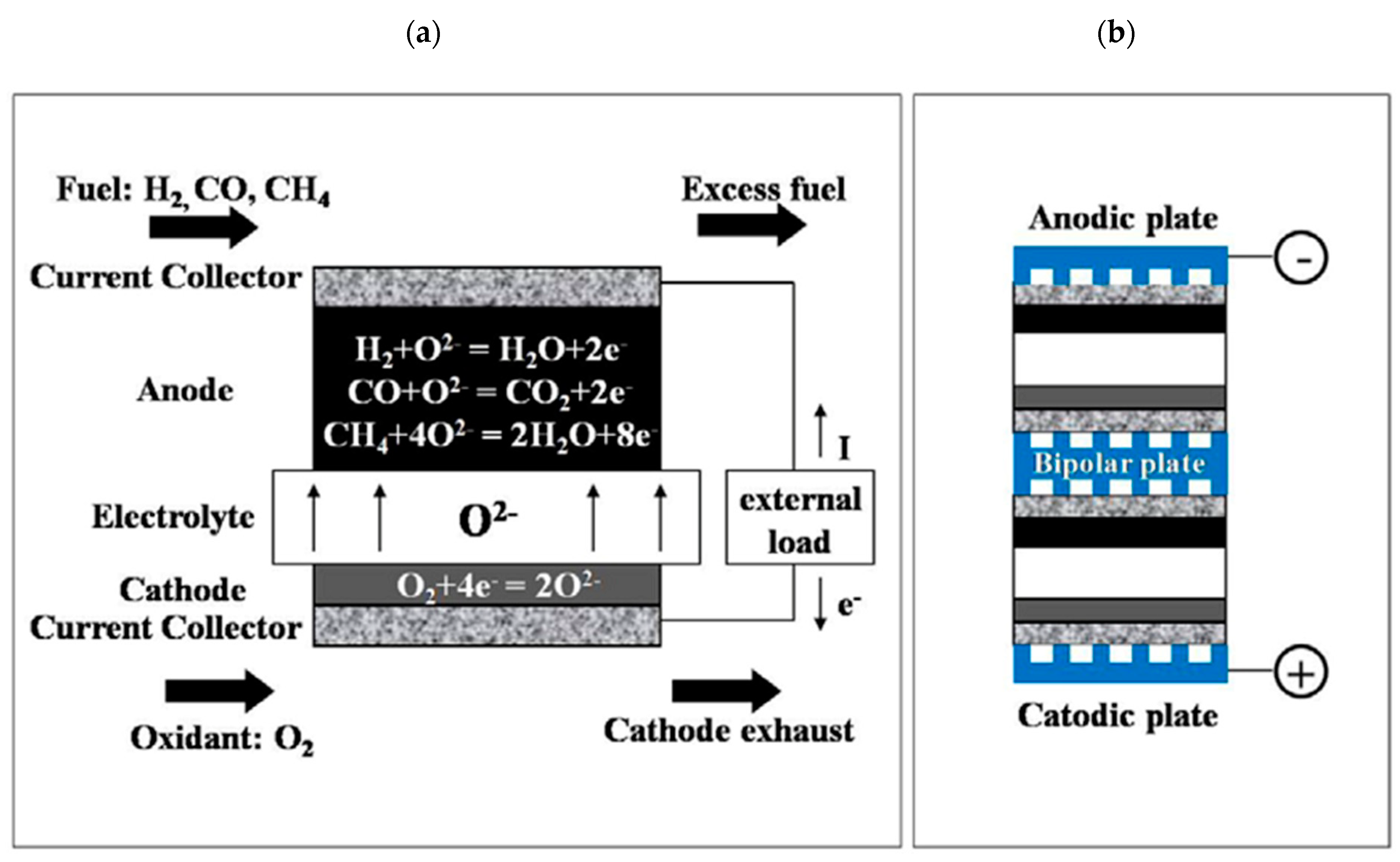
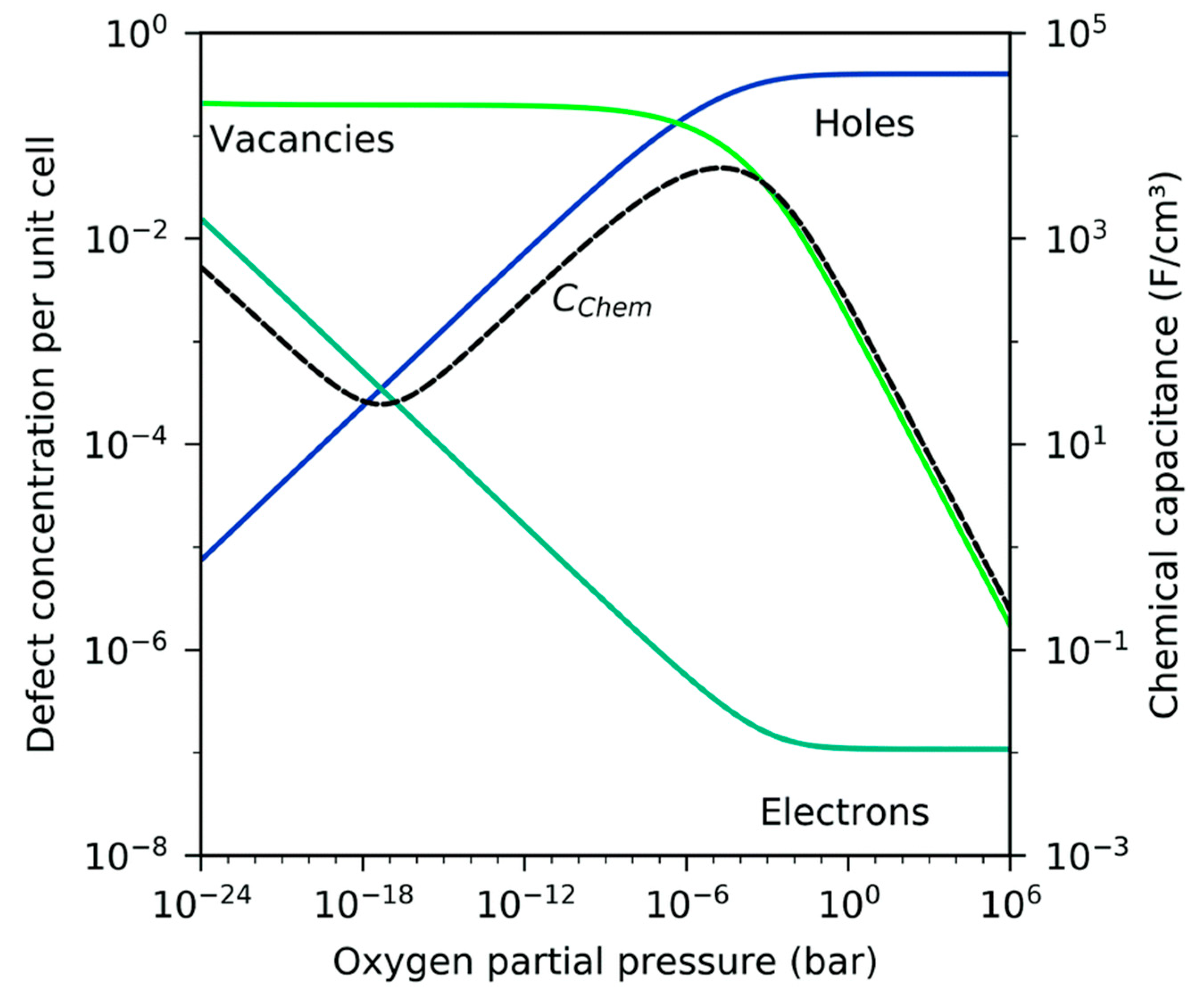
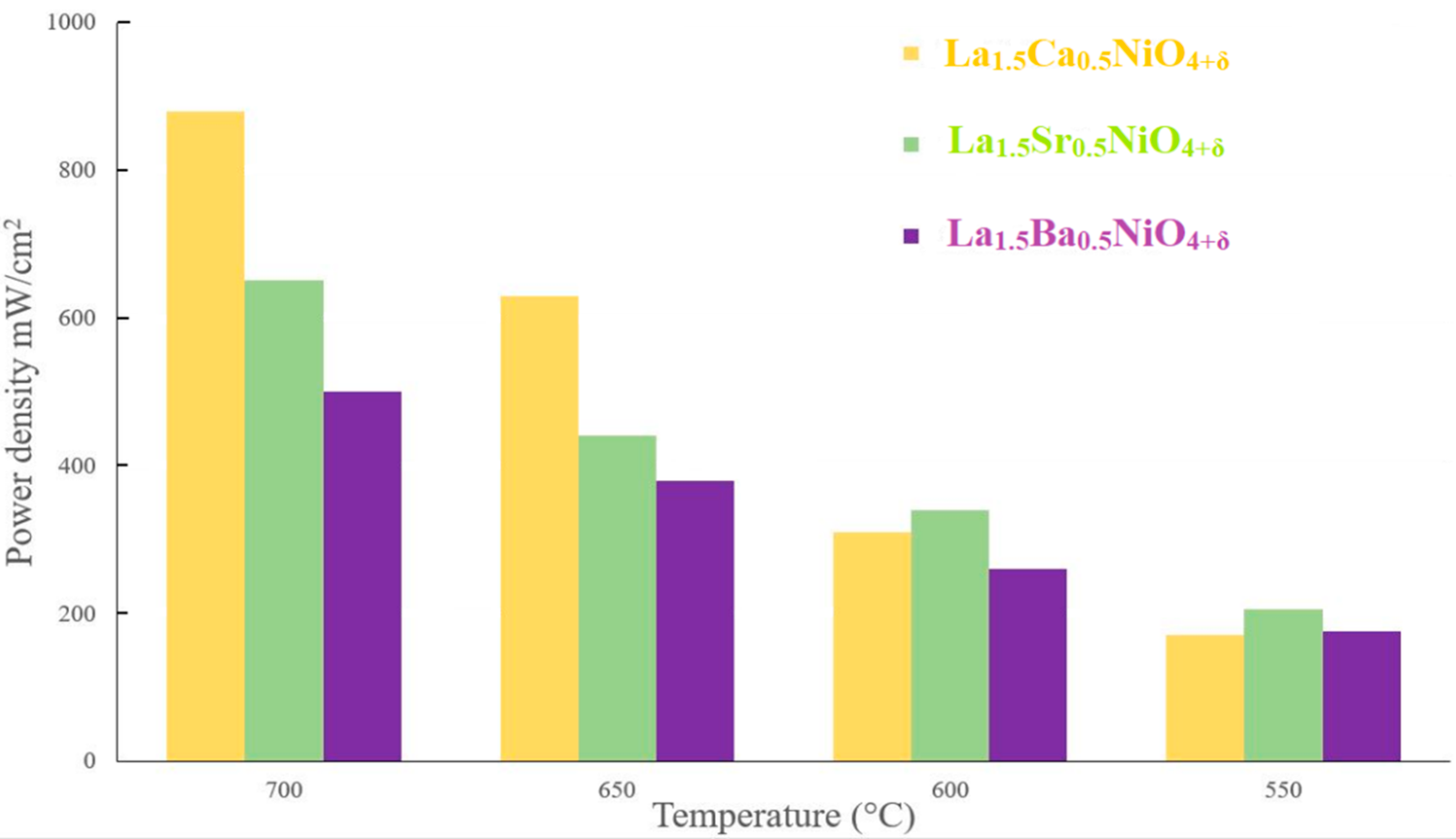
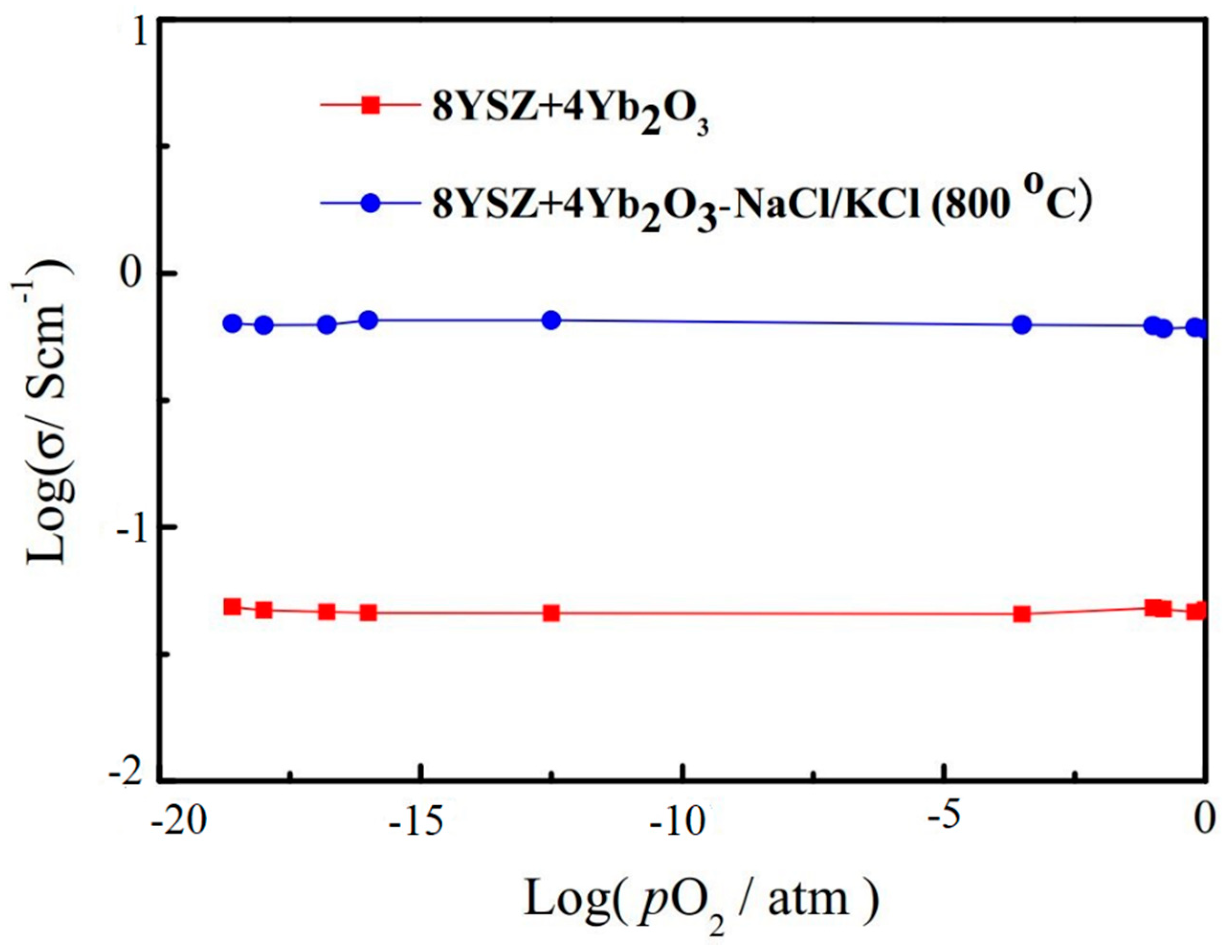
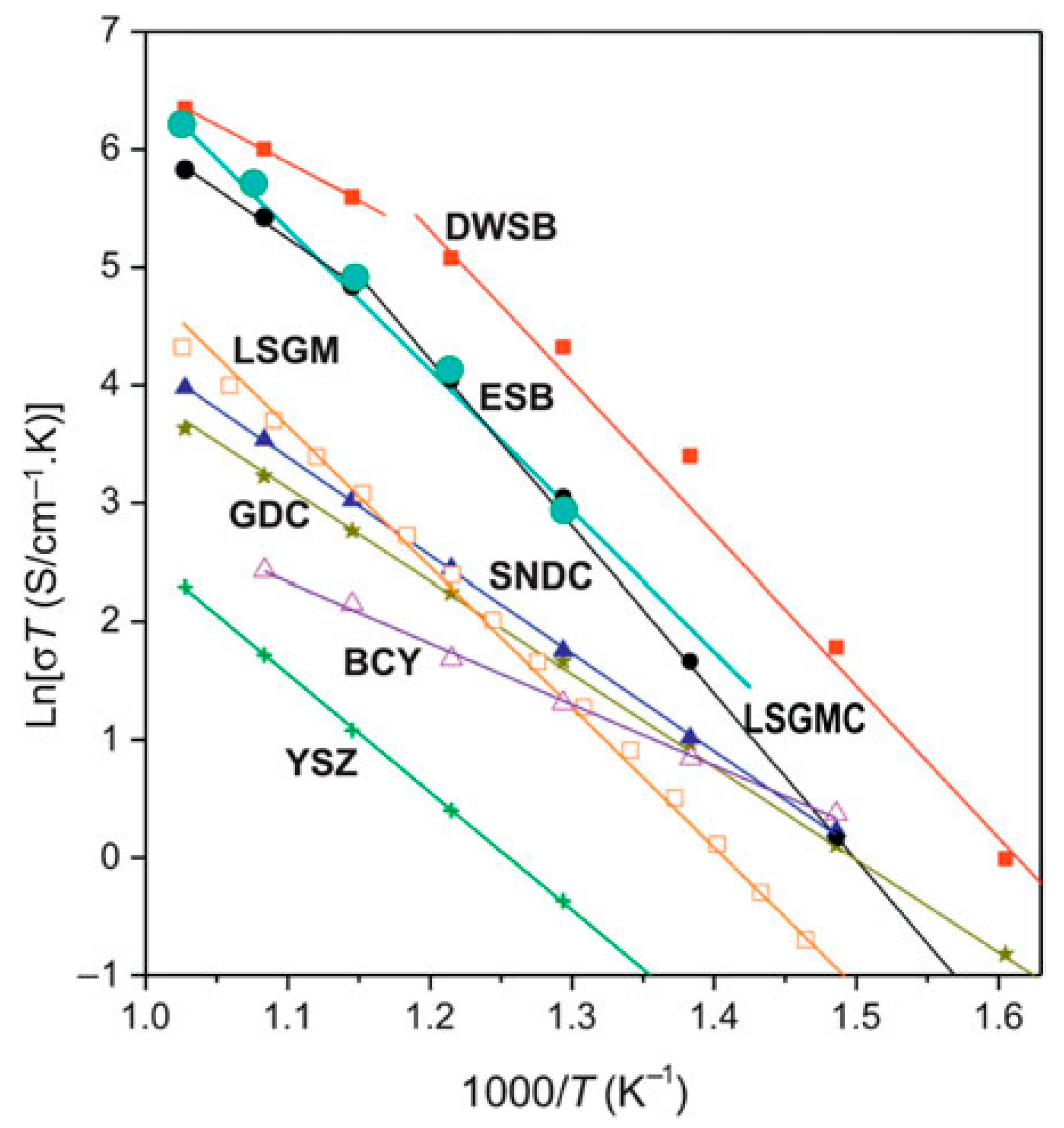
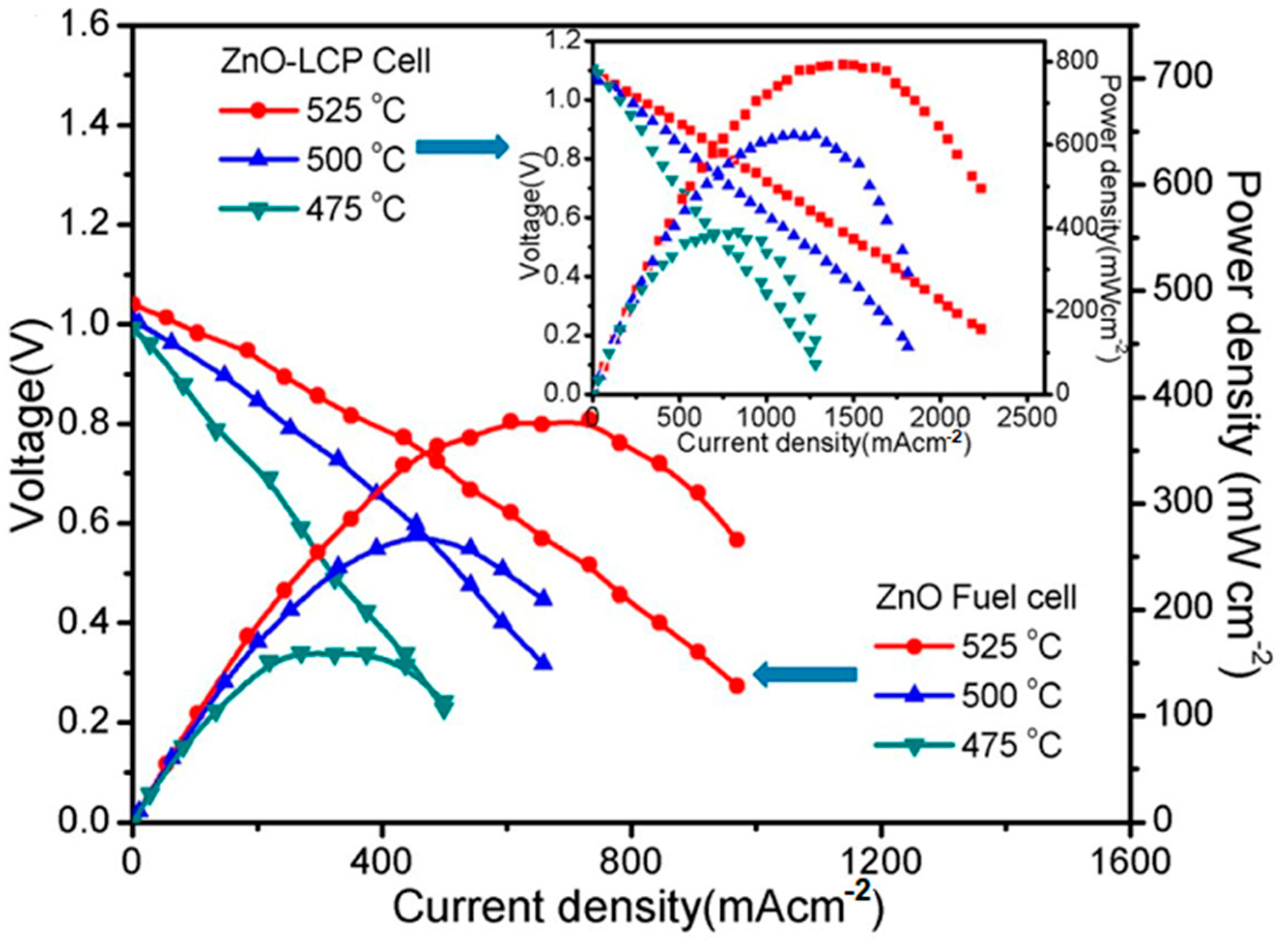
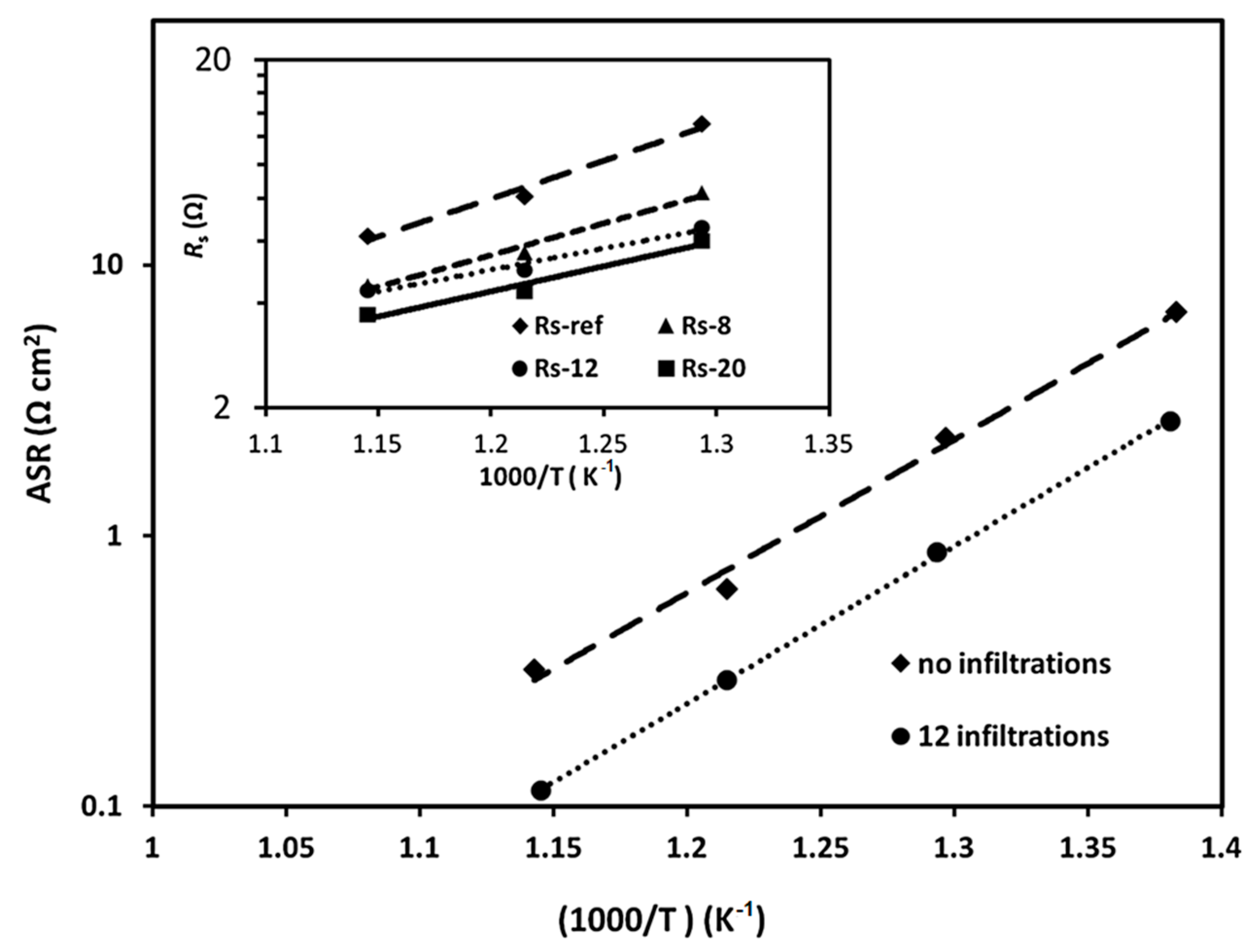
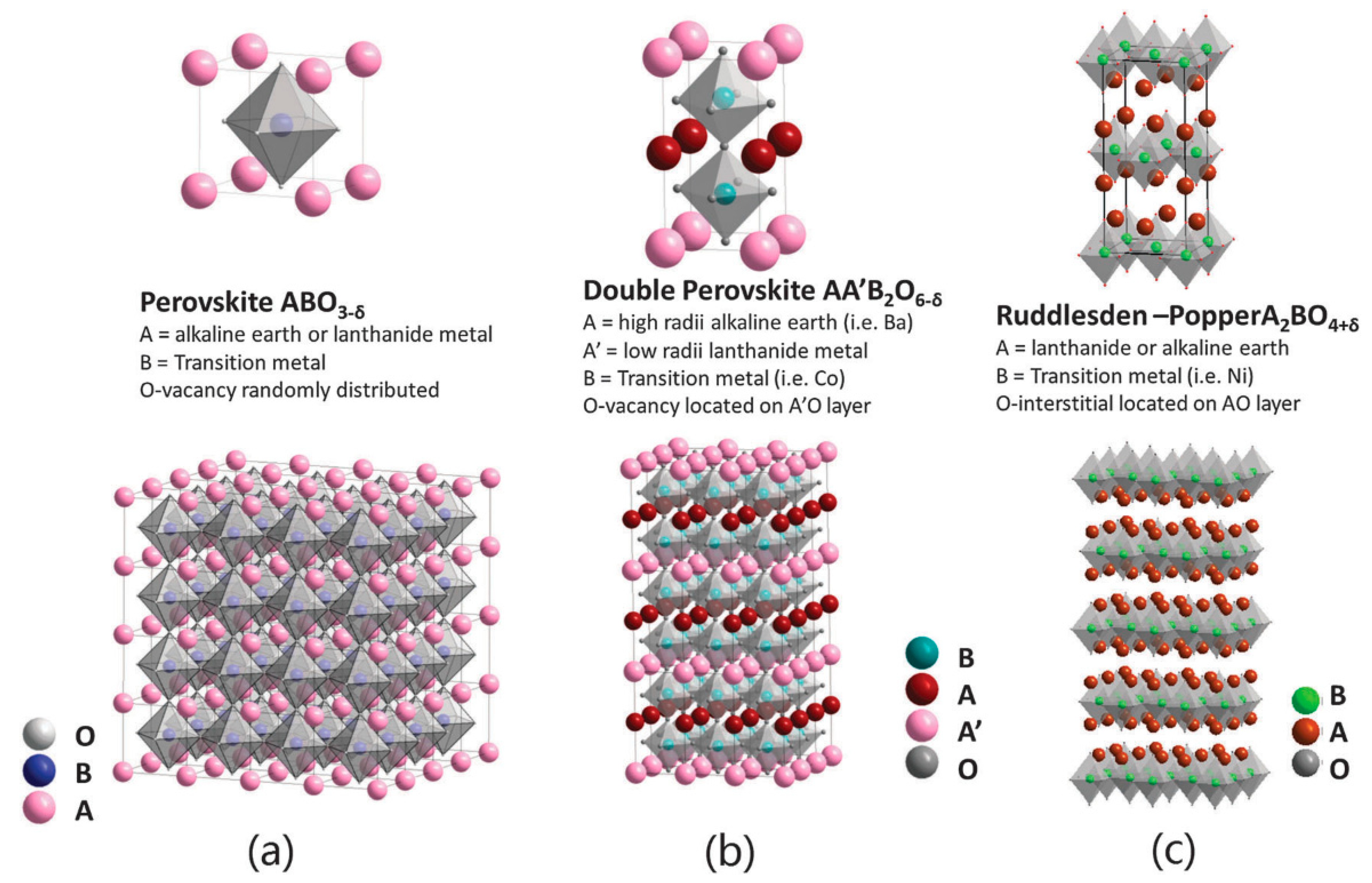
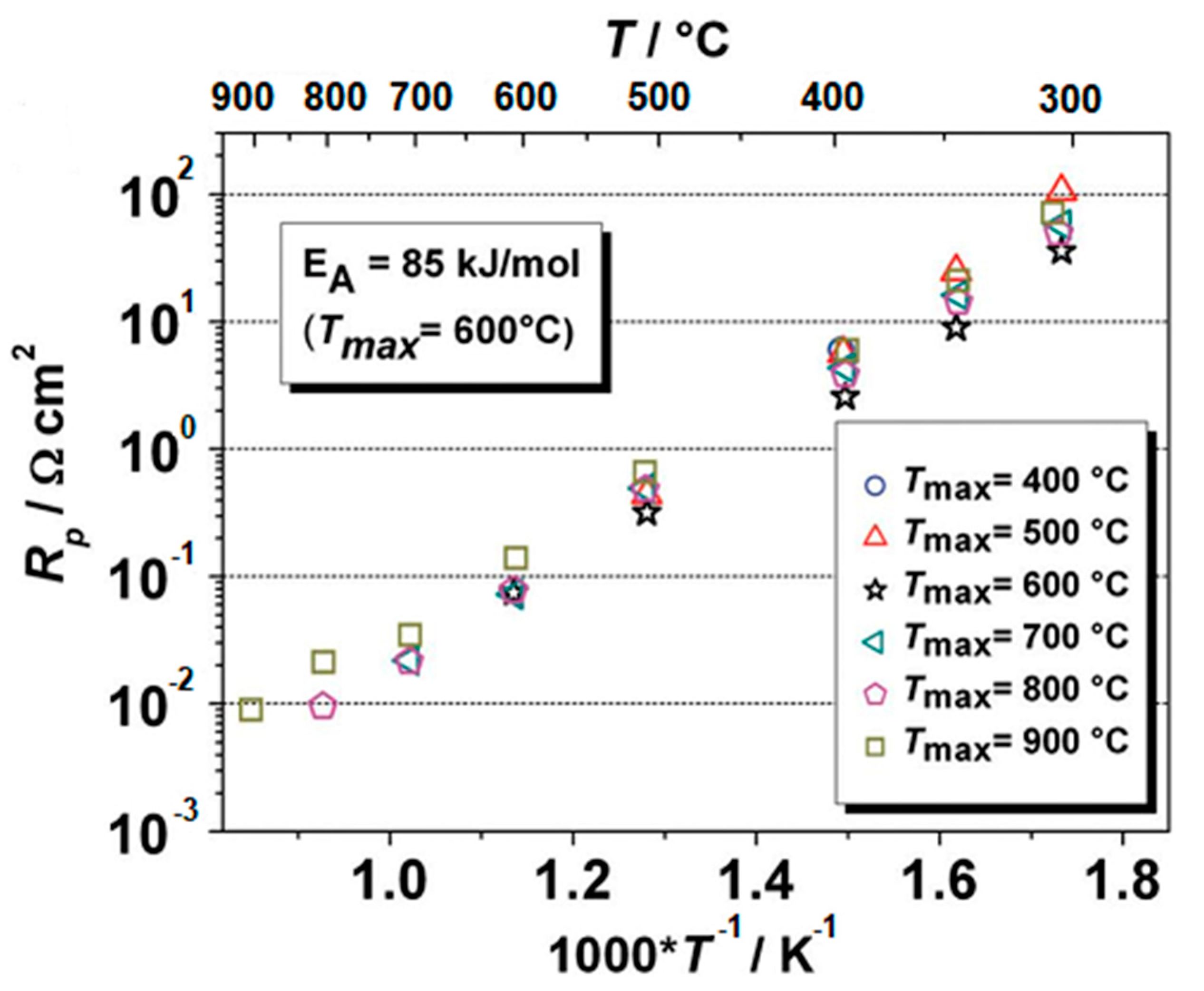
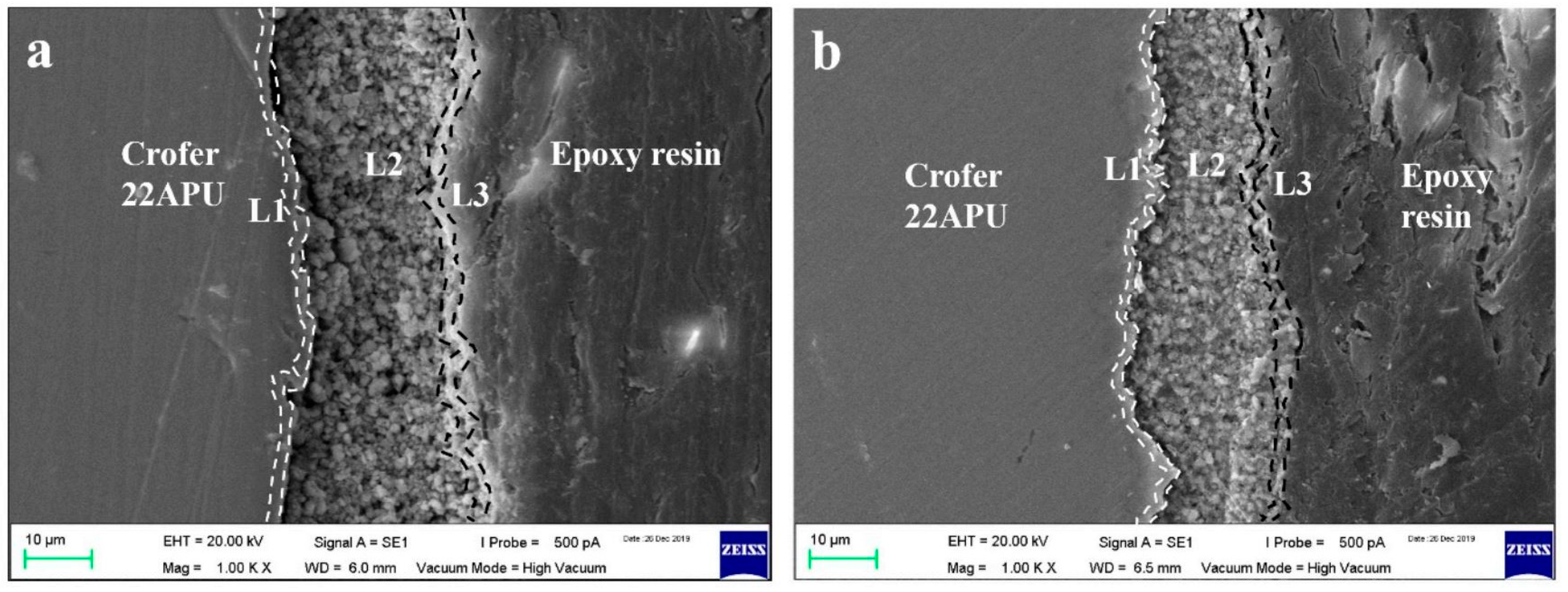

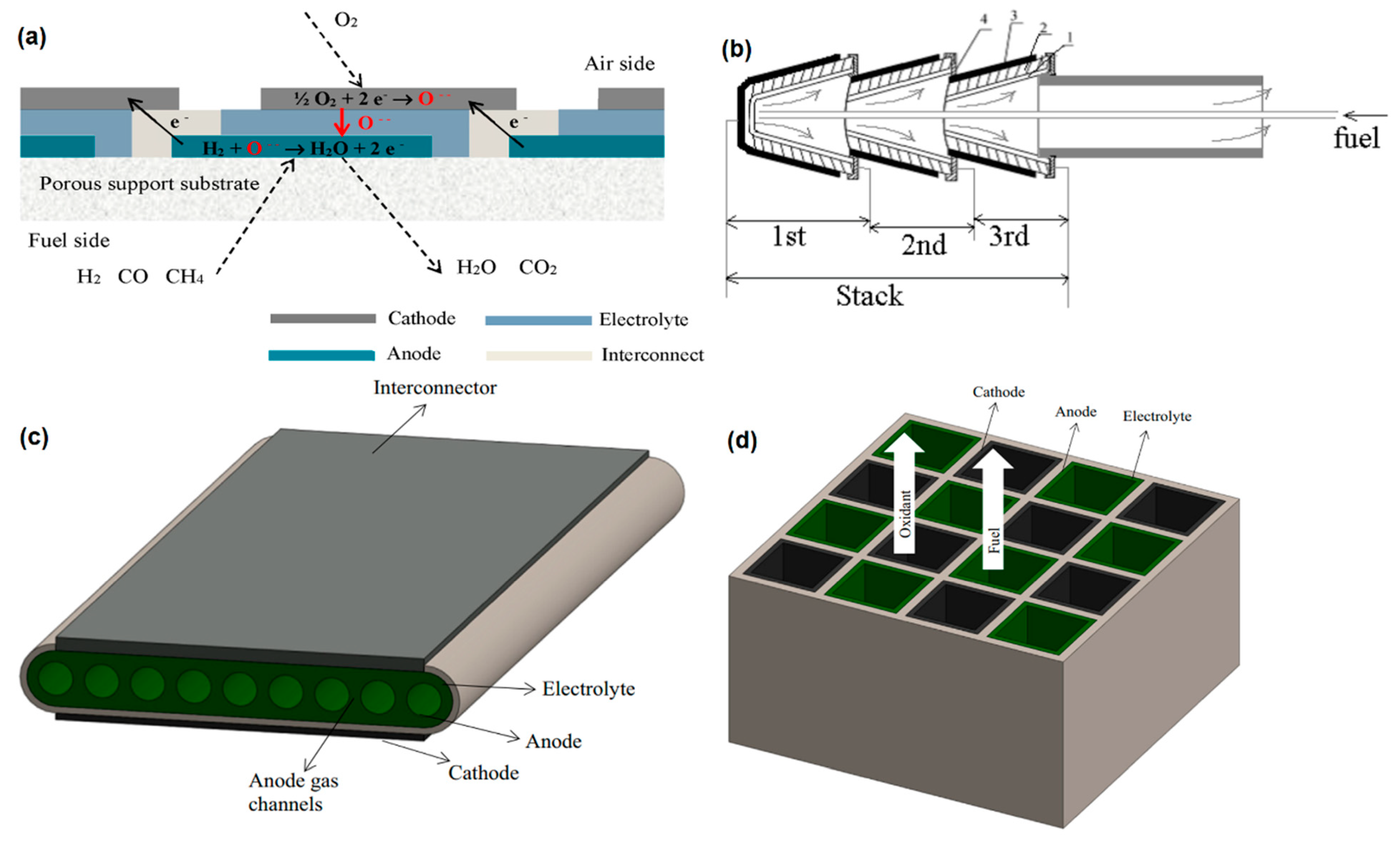
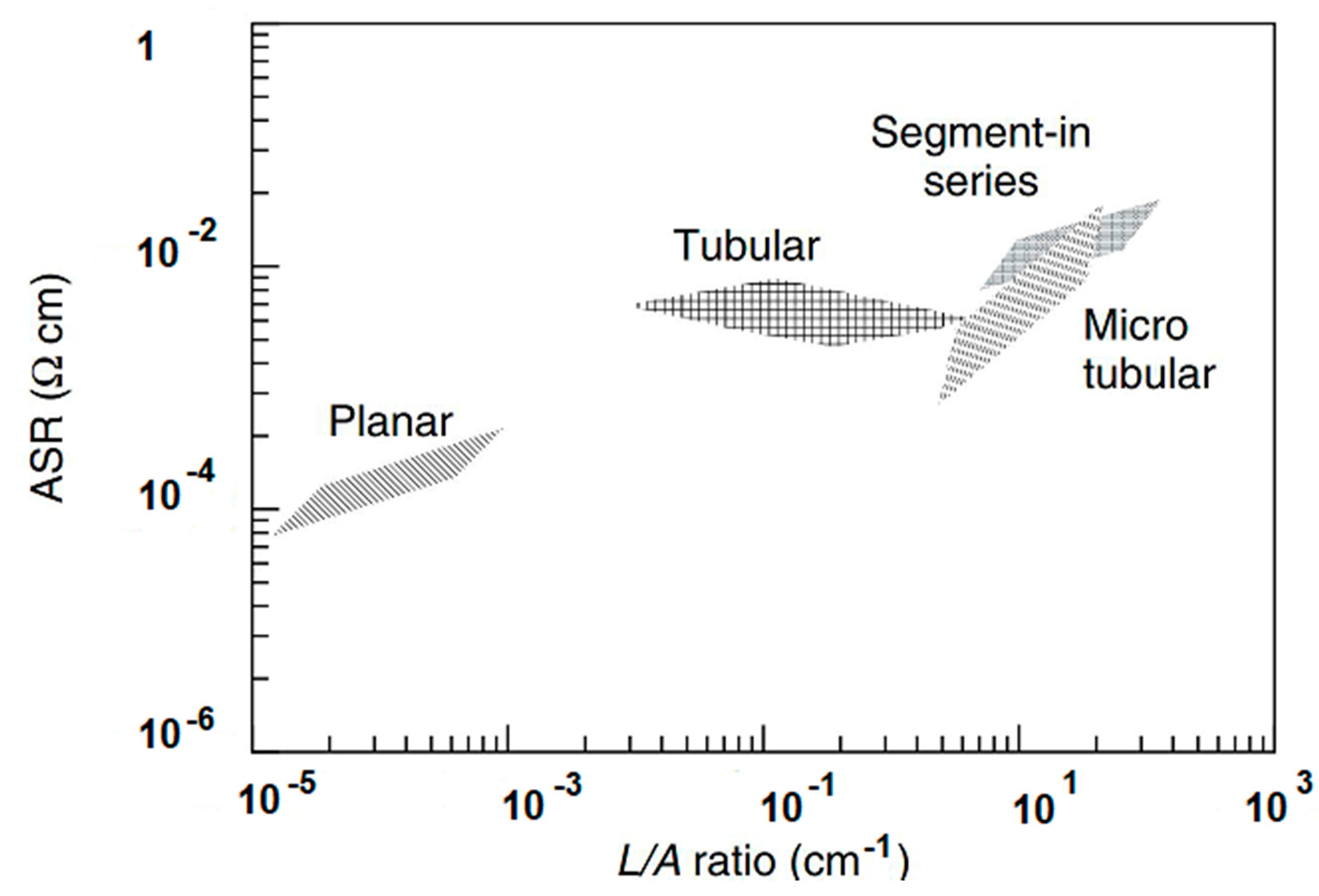
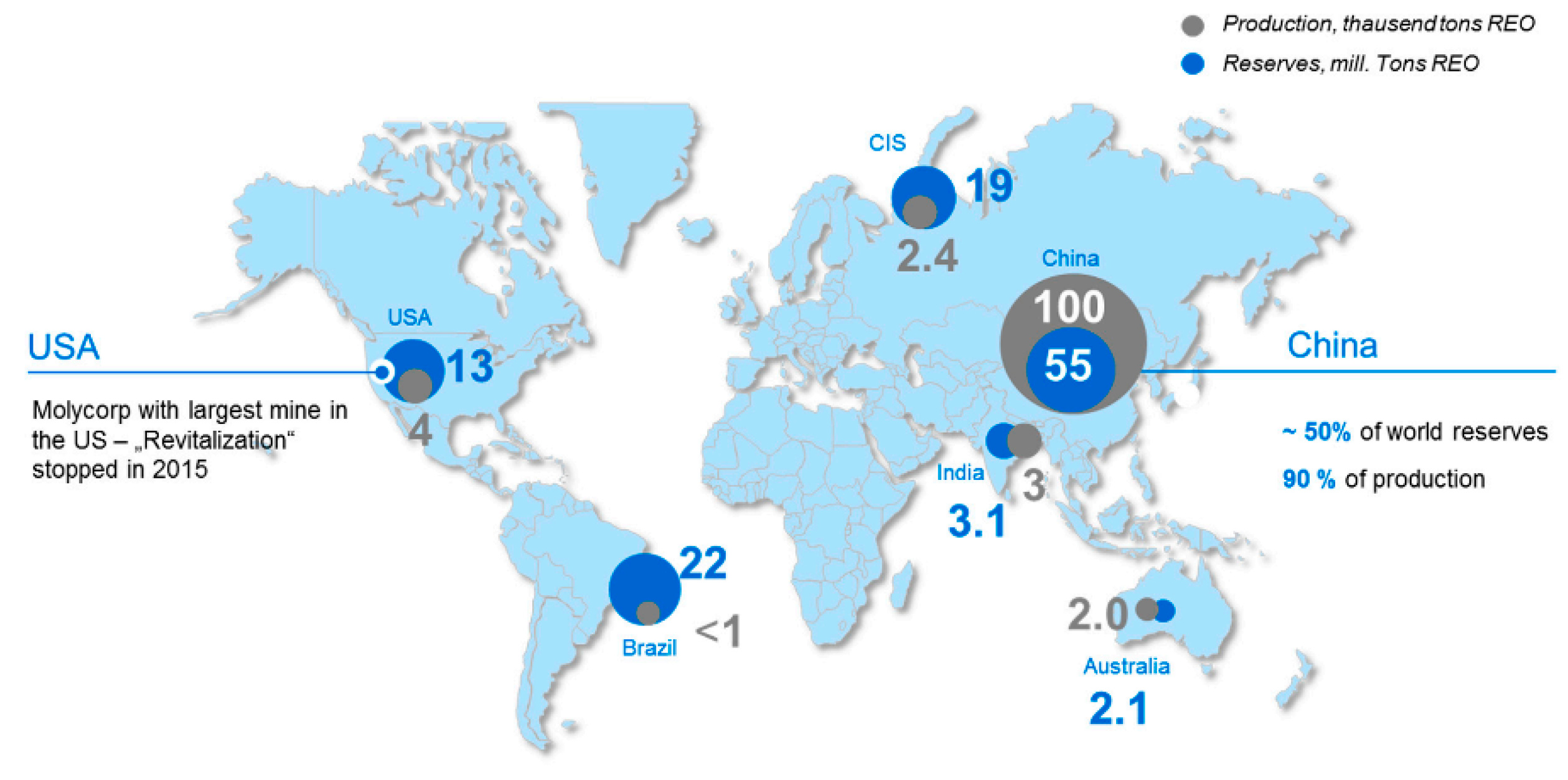
| Cell Geometry | Strength | Weakness |
|---|---|---|
| Anode-supported |
|
|
| Electrolyte-supported |
|
|
| Cathode-supported |
|
|
| Metal-supported |
|
|
| Material | Fabrication Method | Conductivity (S·cm−1) | Temperature (°C) | Ref. |
|---|---|---|---|---|
| GDC | - | 1 × 10−1 | 800 | [146] |
| Ce0.80Sm0.10In0.10O1.90 | Pechini method | 6.009 × 10−3 | 650 | [147] |
| Ce0.80Gd0.17Pr0.03O1.90 | Spray-freezing/freeze-drying | 3.1 × 10−2 | 750 | [166] |
| La9.5Ba0.5Si5.5Al0.5O26.5 | Solid-state reaction | 2.21 × 10−2 | 800 | [167] |
| La9.4Ba0.6Si6O26.7 | Solid-state reaction | ~1.1 × 10−1 | 750 | [168] |
| La9.83Si5Al0.75Fe0.25O26±δ | Mechanochemical activation | 2.04 × 10−2 | 700 | [169] |
| La10Si4.5Cu1.5O27-δ | Sol–gel | 4.8 × 10−2 | 800 | [170] |
| La10Si5.8Mg0.2O26.8 | Solid-state reaction | 8.8 × 10−2 | 800 | [171] |
| La9.8Si5.7Mg0.3O26.4 | Solid-state reaction | 7.4 × 10−2 | 800 | [171] |
| La9.53Si5.7Mg0.3O26 | Solid-state reaction | 4.4 × 10−2 | 800 | [172] |
| La0.8Sr0.2Ga0.85Mg0.15O2.825 | Sol–gel | 1.1 × 10−1 | 800 | [165] |
| La0.85Sr0.15Ga0.85Mg0.15O3−δ | Solid-state reaction | 1.77 × 10−1 | 800 | [173] |
| La0.8Sr0.2Ga0.83Mg0.17O2.815 | Solid-state reaction | 1.7 × 10−1 | 800 | [174] |
| BaZr0.8Y0.20O3−δ | Solid-state reaction | ~1.5 × 10−5 | 900 | [175] |
| BaCe0.9Y0.10O3−δ | Solid-state reaction | ~2.5 × 10−2 | 800 | [176] |
| BaCe0.85Sm0.15O3−δ | Solid-state reaction | 4.75 × 10−2 | 800 | [177] |
| Ba1−xSrxCe0.5Zr0.35Y0.1Sm0.05O3−δ | Solid-state reaction | 2.391 × 10−3 | 700 | [178] |
| Material | Fabrication Method | Conductivity (S·cm−1) | Temperature (°C) | Ref. |
|---|---|---|---|---|
| SCDC | Co-precipitation | 3.9 × 10−2 | 600 | [185] |
| LSCF-SCDC | Co-precipitation | 1.88 × 10−1 | 600 | [185] |
| SDC-(Li/Na/K)2CO3 | Co-precipitation | ~0.7 × 10−1 | 550 | [112] |
| SDC-(35 wt. % lithium-sodium carbonate) | Solid-state reaction | 1.4 × 10−1 | 550 | [203] |
| SDC-(lithium-potassium carbonate) | Solid-state reaction | 7 × 10−2 | 550 | [213] |
| SDC-Na2CO3 | Solid-state reaction | ~7 × 10−2 | 550 | [204] |
| GDC-25 wt. % (Li-Na)2CO3 | Co-precipitation | 1.757 × 10−1 | 550 | [180] |
| GDC-40 wt. % (Li-Na)2CO3 | Simple one-step dry-processing | 1.8 × 10−1 | 500 | [209] |
| LSGM-(Li/Na)2CO3 | Polyacrylamide gel combustion process | ~1.2 × 10−1 | 600 | [211] |
| Ce0.8Sm0.2O1.9-Na2CO3 | Tape casting and hot press | 1 × 10−1 | 550 | [228] |
| Ce0.80Sm0.1Gd0.1O1.9 | Citrate complexation process | 1.8 × 10−2 | 600 | [229] |
| Ce0.80La0.18Ca0.02O1.9 | Citrate/nitrate gel auto-combustion | 1.28 × 10−2 | 600 | [132] |
| Ce0.80Nd0.18Y0.02O1.90 | Citrate/nitrate gel auto-combustion | 1.28 × 10−2 | 600 | [132] |
| Ce0.83Dy0.13Ca0.03O2−δ | Citrate/nitrate gel auto-combustion | 1.45 × 10−2 | 600 | [186] |
| Ce0.85La0.10Ca0.05O2−δ | Solid-state reaction | ~1.8 × 10−2 | 600 | [150] |
| GDC-KAlZn | Solid-state thermal pyrolysis | 6 × 10−2 | 580 | [201] |
| Bi/Gd co-doped ceria | Sol–gel combustion synthesis | 1.29 × 10−2 | 600 | [189] |
| Ce0.80Sm0.1Y0.1O1.9 | Sol–gel | 1.44 × 10−2 | 600 | [148] |
| 10Sc1CeSZ | Tape casting | 2.1 × 10−2 | 600 | [193] |
| 1Ce9ScSZ | Combustion | ~1.1 × 10−2 | 600 | [194] |
| BZCY7 | Solid-state reaction | 9 × 10−3 | 500 | [230] |
| ZnO | Solid-state reaction | 9 × 10−2 | 550 | [141] |
| ZnO-LCP | Solid-state reaction | 1.56 × 10−1 | 550 | [141] |
| 3ZnO-7LCP | Solid-state blending | 2.9 × 10−1 | 550 | [13] |
| La10Si6O27 | Solid-state reaction | 5.8 × 10−3 | 500 | [172] |
| La9.533(Si5.7Mg0.3)O26 | Solid-state reaction | 7.4 × 10−3 | 500 | [172] |
| (La9.33Sr0.67)Si6O26.67 | Solid-state reaction | 6.6 × 10−3 | 500 | [172] |
| La9BaSi6O26.5 | Solid-state reaction | 6.6 × 10−3 | 500 | [219] |
| La10Si5GaO26.5 | Solid-state reaction | 2.4 × 10−3 | 500 | [219] |
| La9.67Si5.5Mg0.5O26 | Solid-state reaction | 3 × 10−3 | 500 | [231] |
| (Dy2O3)13(Ta2O5)2(Bi2O3)85 | Solid-state reaction | 8 × 10−2 | 500 | [227] |
| 10T5WSB | Solid-state reaction | 6.34 × 10−2 | 500 | [223] |
| 8D4WSB | Solid-state reaction | 9.8 × 10−2 | 500 | [159] |
| 13D2TSB | Solid-state reaction | 8 × 10−2 | 500 | [227] |
Publisher’s Note: MDPI stays neutral with regard to jurisdictional claims in published maps and institutional affiliations. |
© 2021 by the authors. Licensee MDPI, Basel, Switzerland. This article is an open access article distributed under the terms and conditions of the Creative Commons Attribution (CC BY) license (http://creativecommons.org/licenses/by/4.0/).
Share and Cite
Fallah Vostakola, M.; Amini Horri, B. Progress in Material Development for Low-Temperature Solid Oxide Fuel Cells: A Review. Energies 2021, 14, 1280. https://doi.org/10.3390/en14051280
Fallah Vostakola M, Amini Horri B. Progress in Material Development for Low-Temperature Solid Oxide Fuel Cells: A Review. Energies. 2021; 14(5):1280. https://doi.org/10.3390/en14051280
Chicago/Turabian StyleFallah Vostakola, Mohsen, and Bahman Amini Horri. 2021. "Progress in Material Development for Low-Temperature Solid Oxide Fuel Cells: A Review" Energies 14, no. 5: 1280. https://doi.org/10.3390/en14051280
APA StyleFallah Vostakola, M., & Amini Horri, B. (2021). Progress in Material Development for Low-Temperature Solid Oxide Fuel Cells: A Review. Energies, 14(5), 1280. https://doi.org/10.3390/en14051280







